Energy Benefits of Heat Pipe Technology for Achieving 100% Renewable Heating and Cooling for Fifth-Generation, Low-Temperature District Heating Systems
Abstract
:1. Introduction and Literature Survey
1.1. Overview
1.2. Buildings and the Environment
1.3. Evolution of District Energy Systems
1.4. District and Heat Pumps
1.5. Low-Temperature District Energy Systems
1.6. Objectives
2. Material and the Method of the Exergy-Based Model and Research
- Decarbonizing the built environment is possible by tapping into the widely available low-temperature renewable and waste heat sources.
- District energy systems may be helpful to achieve this goal.
- However, low-Temperature district energy systems can be successfully applied provided that:
- (a)
- District circuit loop length is optimal concerning pumping exergy spending and thermal exergy distribution. This issue has already been answered (Refer to Reference [37])
- (b)
- The temperature difference between the supply and return piping must be small at low supply temperatures
- (c)
- New low-temperature heating equipment must be developed to minimize or eliminate the necessity for equipment oversizing and temperature peaking.
- (d)
- Temperature peaking with heat pumps defeats the decarbonization objective unless the COP approaches 10. Such a high value may be achieved by cascading heat pumps and de-centralizing.
- (e)
- Heat pipes, wherever they may replace pumps or fans, reduce the CO2 emissions responsibilities economically.
- District size with the number and capacity of the interconnected solar prosuming buildings must be small due to low solar heat temperatures being shared in the circuit. In this respect, sometimes detached solar buildings may be more rational
- Especially in low-temperature applications, exergy rationality must be prioritized.
2.1. Research Design
2.2. Impossible Cases with Existing Comfort Heating Equipment
2.2.1. Case 1
2.2.2. Case 2
2.2.3. Case 3
2.3. Possible Case: New Heating Equipment without or Little Support from Cascaded Heat Pumps
Case 4
2.4. Models of Each Step (1 to 4)
2.4.1. Optimum Pump Control in PVT Panel
2.4.2. PV Life
- If > 0, then the pay-back period increases with n,
- If = 0, then the pay-back period is independent of n,
- If < 0, then the pay-back period decreases with n.
- n—Capacity Factor
- m—Temperature Drift Factor
2.4.3. Solutions for Figure 20
3. Analysis of Heat Pipe Radiator
3.1. Comparison with Standard Radiator
3.2. Exergy-Levelized Cost, ELC
4. Case Study: To Centralize or Not to Decentralize Solar Prosumers
4.1. Dezonnet Project
4.1.1. Description of the Project
4.1.2. Individual Solar Houses with Heat Pipe Technology
- The solar district system has been changed to individual solar buildings in a disconnected mode. This approach eliminates to large central thermal storage (ATES) system and eliminates the district pumping stations and pumps. This measure also eliminated the entire district piping, which comes with large embodiments and infrastructural costs. The savings were directed to new heat-pipe radiators and ceiling panels instead of oversizing standard radiators. In the same manner, savings were used to retrofit commercial PVT panels with PVT3 panels.
- Heat Pump COP optimized additional thermal insulation was applied to exterior walls.
- Heat pipe technology was extensively used in PVT panels, heating and cooling equipment, and local TES systems.
- Heat Pump refrigerant was changed from commercial refrigerants to CO2 gas. By using CO2 gas, ozone depletion and global warming effects have been eliminated down to negligible proportions. Furthermore, by using CO2 gas, the same amount is deducted from the emissions stock.
- Heat pump COP was increased by using two tandem heat pumps. This method reduces the solar electricity demand on board the building and at the same time minimizes CO2 refrigerant leakages from them.
- Night cooling from the PVT3 panels with a heat pipe connection indoors reduces the cooling loads.
5. Overall Discussion
6. Conclusions
- This paper is expected to holistically extend the vision already opened by Shukuya, to the policymakers for improving their road maps and expanding their current strategies for decarbonization. The following takeaways may be recognized:
- Development and commercialization of low-temperature heating and high-temperature cooling equipment with minimum CO2, energy, cost, exergy embodiments, and affordable enough for easy retrofit must be prioritized, and R&D activities supported specifically with EU grants and other mechanisms, worldwide.
- Heat pipe technology for aiming the maximum efficiency and minimum exergy losses, savings in material, and weight in the buildings must be prioritized along three main vectors, namely the solar PVT systems, short-term energy storage (With PCM), and the equipment themselves.
- Until new heating and cooling equipment widely penetrate the building sector, tools for optimum design of oversizing the existing heating and cooling equipment and assisting with high-COP heat pumps in a tandem format must be developed and provided to the design market and building engineers and architects.
- New-generation solar PVT systems must be implemented to utilize the solar exergy for given solar insolation areas in and around the buildings.
- Public and government awareness about the exergy dimension of the solution for global warming must be raised by publications, seminars, and online educational packages. It must be emphasized that the methodology presented in this paper makes the information transition and practice much easier to grasp and implement.
- District energy concepts with low-temperature heating and high-temperature cooling are rising in the political and engineering agenda. This seemingly effective way of decarbonization, the district thermal exergy circulated versus the pumping exergy demand must be noted by policymakers, and future designs for 100% RHC cities must be a prerequisite.
- Total electrification by heat pumps concept is also on the rise by the influence of the heat pipe industry. Yet according to the 2nd Law of Thermodynamics, as clearly explained in this paper, COP values must be increased by innovations, and optimum cascading of heat pumps must become a general practice.
- The concept of Renewable Energy Cities must be transitioned to the concept of Renewable Exergy Cities if sustainable decarbonization is the real agenda with the recognition that decarbonization is a matter of minimizing exergy destructions, beyond increasing the energy efficiency.
- Today, exergy becomes first within the general energy, environment, water, and welfare nexus. This must be widely acknowledged by all means (see [53]).
- It must be realized that the exergy rationality concept is not only a game-changer but moreover is a game maker that must be taken into an advantage.
- Sometimes low-temperature district energy systems may not be effective in CO2 emissions responsibility. Then individual green buildings or smaller-sized districts must be on the energy agenda.
Author Contributions
Funding
Institutional Review Board Statement
Informed Consent Statement
Conflicts of Interest
Nomenclature
| Symbols | |
| Ap | Solar Panel Area, m2 |
| AUST | Area Average of Un-Conditioned Indoor Surface Temperatures, K |
| c | Equipment heating capacity factor (Equations (48) and (61)), kW/K |
| c` | Unit CO2 emission value of fossil fuel, kg CO2/kW-h |
| c``, c``` | Constants in Equation (35) |
| Cp | Specific Heat, J/kg K |
| CO2 | Direct CO2 emissions, kg CO2/kW-h |
| COP | Coefficient of Performance (Heat Pump) |
| d | Constant in Equation (60) |
| dTt | Temperature Deficit Between Optimum Heat Pump Output (supply) Temperature and Optimum Equipment Input Temperature, (Equation (50)) K |
| C1 | Tfhp − Tg, K (Figure 24) |
| C2 | Tfeq − Ta, K (Figure 24) |
| Ceq | Life-Cycle Cost Factor for Equipment, €/kW-h [46] |
| Chp | Life-Cycle Cost Factor for Heat Pump, €/kW-h [46] |
| Ct | Life-Cycle Cost Factor for Auxiliary Heater, €/kW-h [46] |
| Co-t | Life-Cycle Cost of Auxiliary Heater (to be added to equipment and heat pump life-cycle costs) |
| E | Electric Power, kW |
| ELC | Exergy-Levelized Cost, €/(kWEXpeak/m2) |
| ELCCO2 | Exergy-Levelized CO2 Emissions Cost, kg CO2/(kWEXpeak/m2) |
| EXH | Thermal Exergy, kW |
| F` | Oversizing Factor (Equation (32)) |
| GWP | Global Warming Potential |
| h | Heat Transfer Coefficient, kW/m2K |
| ID | Internal Tube (Pipe) Diameter, m |
| In | Solar Insolation Normal to the PV Panel Surface, kW/m2 |
| l | Oversizing Multiplier in Equation (11) |
| L | Length of District Loop, m |
| LP | Life of Solar Panel |
| MOC | Tube Spacing on Centers, m (Equation (38)) |
| n | Number of Floors in a Building |
| ODI | Ozone Depleting Index |
| ODP | Ozone Depletion Potential |
| REX | Exergy-based share of renewable energy sources by installed capacity in the energy stock |
| Np | Number of Parallel Piping in the District Energy System |
| Nf | Temperature Life Cycle |
| P | Pump Power, kW |
| q, r | Heat Pump COP multipliers (Equation (56)), q is dimensionless r has a unit of K−1 |
| Q | Heat Load, Heat Supply, kW |
| Qo | Rated Heat Capacity, kW |
| QWP | Qo/Wp, kW/kg |
| q | Heat Flux, kW/m2 |
| r | Thermal Resistance, m2K/W |
| RRM | Radiator Capacity Increase per Oversizing Ratio, kW/kg |
| T | Temperature, K or °C |
| t | Time, s |
| U` | Heat Load Coefficient of The Building, kW/K |
| Volumetric Flow Rate, m3/s | |
| W | Weight, kg |
| w | Constant in Equation (25) |
| WD | Weight Metric (Equation (47)), kg−1 |
| Wp | Weight of the Radiator, kg |
| WW | Weight of Water Content of the radiator (SR), kg |
| y | Constant in Equation (28) |
| Greek Symbols | |
| ΔCO2 | Nearly-Avoidable CO2 Emissions Due to Exergy Destructions, kg CO2/kW-h |
| ΣCO2 | Total CO2 emission (Sum of Direct and Nearly-Avoidable Emissions), kg CO2/kW-h |
| ΔH | Heat Deficit, kW |
| ψR | Rational Exergy Management Efficiency |
| E | Unit exergy, kW/kW |
| B | Thermal constant of PV Efficiency |
| η, ηI | First-Law Efficiency |
| R | Mass Density, kg/m3 |
| Subscripts | |
| a | Indoor Air |
| Boiler | Boiler |
| D | District |
| dem | Demand |
| des | Destroyed |
| eq | Equipment |
| f | Carnot Cycle-Based Equivalent (Virtual) Energy Source Temperature-related or adiabatic flame temperature of fossil fuel, or source temperature of renewable thermal energy sources-related, fuel |
| fuel | Fuel |
| H | Heat |
| HE | Heat Exchanger |
| in | Inner, input |
| ins | Thermal Insulation |
| m | Mean (Average) Temperature, K |
| max | Maximum |
| mo | Electric Motor |
| 0 | Original (Design, Rated) Value |
| opt | Optimum |
| P | Panel, pump |
| out | Out |
| peak | Peak |
| ref | Reference |
| S | Steam |
| sup | Supply |
| UL | Ultra-Low (Temperature) |
| x | Exergy |
| Superscripts | |
| ` | Modified, Secondary |
| n | Equipment Heating Capacity Exponent |
| m | Additional Equipment Heating Capacity Exponent |
| Abbreviations | |
| ATES | Aquifer Thermal Energy Storage |
| 1DE (or 1G) | First-Generation District Heating |
| 5DE | Fifth-Generation District Energy System |
| 5DE+ | Beyond 5DE |
| AC | Alternating Current |
| ATES | Aquifer Thermal Energy Storage |
| BAU | Business as Usual |
| CC | Carbon Capture |
| CCS | Carbon Capture and Storage |
| DC | Direct Current |
| EHP | Enover Heat Pipe |
| EU | European Union |
| F/C | Fan Coil |
| G | Generation (District Energy System) |
| GHG | Green House Gas Emissions |
| HPR | Heat Piper Radiator |
| HVAC | Heating, Ventilating, and Air Conditioning |
| IAQ | Indoor Air Quality |
| HP | Heat Pump |
| IEA | International Energy Agency |
| LT | Low-Temperature |
| LowEx | Low-Exergy (Building) |
| OECD | Organization for Economic Co-operation and Development |
| PCM | Phase-Changing Material |
| PMPPT | Direct Power MPPT (Maximum Power Point Tracking) |
| PV | Photovoltaic Cell (Panel) |
| PVT | Photo-Voltaic-Thermal |
| PVT1 | First-Generation (Simple) PVT |
| REMM | Rational Exergy Management Model |
| 100REC | 100% Renewable Energy City |
| 100REXC | 100% Renewable Exergy City |
| RHC | Renewable Heating and Cooling |
| SR | Standard (Conventional) Hydronic Radiator for Indoor Heating |
| TES | Thermal Energy Storage |
| TEG | Thermo-Electric Generator |
Appendix A. Explanation of Figure 2
(Depending upon the heating or cooling system, Relative Humidity, and AUST)
References
- Council Decision (EU). 2016/1841 of 5 October 2016 on the Conclusion, On Behalf of the European Union, of the Paris Agreement Adopted under the United Nations Framework Convention on Climate Change. 2016. Available online: https://eur-lex.europa.eu/legal-content/EN/TXT/PDF/?uri=CELEX:32016D1841&from=EN (accessed on 10 August 2021).
- OECD. The OECD Environmental Outlook to 2050 Key Findings on Climate Change. Available online: https://www.oecd.org/env/cc/Outlook%20to%202050_Climate%20Change%20Chapter_HIGLIGHTS-FINA-8pager-UPDATED%20NOV2012.pdf (accessed on 10 August 2021).
- Hawksworth, J. The World in 2050 Can Rapid Global Growth Be Reconciled with Moving to a Low Carbon Economy? Price Water Coopers: London, UK, 2008; 22p, Available online: https://www.pwc.com/gx/en/psrc/pdf/world_in_2050_carbon_emissions_psrc.pdf (accessed on 10 August 2021).
- ACS. What is the Greenhouse Gas Changes since the Industrial Revolution? ACS Climate Science Toolkit Greenhouse Gases. Available online: https://www.acs.org/content/acs/en/climatescience/greenhousegases/industrialrevolution.html (accessed on 10 August 2021).
- Kilkis, B. Sustainability and Decarbonization Efforts of the EU: Potential Benefits of Joining Energy Quality (Exergy) and Energy Quantity (Energy). In EU Directives, A State of the Art Survey and Recommendations, Exclusive EU Position Report; TTMD: Ankara, Turkey, 2017. [Google Scholar]
- SE. In a Resource-Constrained World: Think Exergy, Not Energy’ D/2016/13.324/5, Science Europe. Available online: https://www.scienceeurope.org/media/0vxhcyhu/se_exergy_brochure.pdf (accessed on 10 August 2021).
- EC. Most Residential Buildings Were Built before Thermal Standards Were Introduced, How Do You Know? Energy, Chart: Breakdown of Residential Building by Construction Year. 2014. Available online: https://ec.europa.eu/energy/content/most-residential-buildings-were-built-thermal-standards-were-introduced_en (accessed on 10 August 2021).
- NOVEM. Méér Comfort Metminder Energie, LTV Brochure, Rotterdam, Holland. 2011. Available online: http://www.passiefhuis.info/bouwen/nederland/senternovem/138389_LTV_brochure_tcm24-105131.pdf (accessed on 24 August 2021).
- Eijdems, H.H.E.W.; Boerstra, A.C.; Op’t Veld, P.J.M. Low-Temperature Heating Systems Impact on IAQ, Thermal Comfort, And Energy Consumption. In Proceedings of the 21st AIVC Conference, The Hague, The Netherlands, 26–29 September 2000. [Google Scholar]
- IEA. EBC Annex 37, LowEx, Literature Review: Side Effects of Low Exergy Emission Systems; Novem BV: Sittard, The Netherlands, 2000; 100p, Available online: https://annex53.iea-ebc.org/Data/publications/EBC_Annex_37_literature_review.pdf (accessed on 10 August 2021).
- Kilkis, S. System Analysis of a Pilot Net-Zero Exergy Distric. Energy Convers. Manag. 2014, 87, 1077–1092. [Google Scholar] [CrossRef]
- Kilkis, B. Equipment Oversizing Issues with Hydronic Heating Systems. ASHRAE J. 1998, 40, 25–30. [Google Scholar]
- Leskinen, N.; Vimpari, J.; Seppo Junnil, S. A Review of the Impact of Green Building Certification on the Cash Flows and Values of Commercial Properties. Sustainability 2020, 12, 2729. [Google Scholar] [CrossRef] [Green Version]
- Kılkış, B.; Kılkış, Ş. Rational Exergy Management Model for Effective Utilization of Low-Enthalpy Geothermal Energy Resources. Hittite J. Sci. Eng. 2018, 5, 59–73. [Google Scholar] [CrossRef]
- Gawer, R.; Cezarz, N. Stanford University: Economic, Efficient, Green District Low-Temperature Hot Water. In Proceedings of the IDEA Annual Conference, Detroit, MI, USA, 10–13 July 2016. [Google Scholar]
- UNEP. District Energy in Cities, Unlocking the Potential of Energy Efficiency and Renewable Energy; UNEP DTIE Energy Branch: Paris, France, 2015; Available online: http://wedocs.unep.org/bitstream/handle/20.500.11822/9317/-District_energy_in_cities_unlocking_thepotential_of_energy_efficiency_and_renewable_ene.pdf?sequence=2&isAllowed=y (accessed on 10 August 2021).
- Zhivov, A.M.; Vavrin, J.L.; Woody, A.; Fournier, D.; Richter, S.; Droste, D.; Paiho, S.; Jahn, J.; Kohonen, R. Evaluation of European District Heating Systems for Application to Army Installations in the United States; Report No. ERDC/CERL TR-06-20; Construction Engineering Research Laboratory, US Army Corps of Engineers: Champaign, IL, USA, 2006; 246p. [Google Scholar]
- C40 Cities. 98% of Copenhagen City Heating Supplied by Waste Heat, 3 November 2011. 2011. Available online: https://www.c40.org/case_studies/98-of-copenhagen-city-heating-supplied-by-waste-heat (accessed on 24 August 2021).
- Schneider Electric. Termis, District Energy Management, User Guide, 5th ed.; Schneider Electric: Ballerup, Denmark, 2012; Available online: https://download.schneider-electric.com/files?p_enDocType=User+guide&p_File_Name=Termis_5_0.pdf&p_Doc_Ref=Termis+Set+Up+Guide (accessed on 14 August 2021).
- Bloomquist, R.G.; O’Bien, R. Software to Design and Analyze Geothermal District Heating and Cooling Systems, and Related Air Quality Improvement, World Geothermal Congress. Transactions 1995, 4, 2999–3003. [Google Scholar]
- Coudert, J.M. Geothermal Direct Use in France: A General Survey, Geo-Heat Center Quarterly Bulletin; Geoheat Center: Klamath Falls, OR, USA, 1984; Volume 8, pp. 3–5. [Google Scholar]
- Jinrong, C. Geothermal Heating System in Tanggu Tianjin, China, Geo-Heat Center Quarterly Bulletin; Geoheat Center: Klamath Falls, OR, USA, 1992; Volume 14, pp. 11–15. [Google Scholar]
- Jaudin, F. County Update France. International Symposium on Geothermal Energy Transactions. Geotherm. Resour. Counc. 1990, 14 Pt 1, 63–69. [Google Scholar]
- Gudmundsson, O. Distribution of District Heating, 1st ed.; Danfoss: Nordborg, Denmark, 19 September 2016; Available online: https://assets.danfoss.com/documents/57292/BE346042889071en-010101.pdf (accessed on 14 August 2021).
- Park, H.; Kim, M.S. Theoretical Limit on COP of a Heat Pump from a Sequential System. Int. J. Air-Cond. Refrig. 2015, 23, 1550029. [Google Scholar] [CrossRef]
- Ding, R.; Du, B.; Xu, S.; Yao, J.; Zheng, H. Theoretical Analysis and Experimental Research of Heat Pump Driving Heat Pipes Heating Equipment. Therm. Sci. 2019, 24, 329. [Google Scholar] [CrossRef]
- Tol, H.I. District Heating in Areas with Low Energy Houses. DTU Civil Engineering Report R-283 (UK). Ph.D. Thesis, Technical University of Denmark (DTU), Kongens Lyngby, Denmark, February 2015. [Google Scholar]
- Kilkis, B. Environmental Economy of Low-Enthalpy Energy Sources in District Energy Systems, HI-02-03-2. In Proceedings of the ASHRAE Transactions, Atlantic City, NJ, USA, 12–16 January 2002; pp. 580–587. [Google Scholar]
- Kilkis, B. An Analytical Optimization Tool for Hydronic Heating and Cooling with Low-Enthalpy Energy Resources, Hi-02-14-2. In Proceedings of the ASHRAE Transactions, Atlantic City, NJ, USA, 12–16 January 2002; pp. 968–996. [Google Scholar]
- Hongwei, L.; Svend, S. Energy and Exergy Analysis of Low-Temperature District Heating Network. Energy 2012, 45, 237–246. [Google Scholar] [CrossRef]
- Wheatcroft, E.; Henry Wynn, H.; Lygnerud, K.; Bonvicini, G.; Leonte, D. The Role of Low-Temperature Waste Heat Recovery in Achieving 2050 Goals: A Policy Positioning Paper. Energies 2020, 13, 2107. [Google Scholar] [CrossRef] [Green Version]
- Antal, M.; Cioara, T.; Anghel, L.; Gorzenski, R.; Januszewski, R.; Oleksiak, A.; Piatek, W.; Pop, C.; Salomie, I.; Szeliga, W. Reuse of Data Center Waste Heat in Nearby Neighborhoods: A Neural Networks-Based Prediction Model. Energies 2019, 12, 814. [Google Scholar] [CrossRef] [Green Version]
- Grassi, B.; Piana, E.A.; Beretta, G.P.; Pilotelli, M. Dynamic Approach to Evaluate the Effect of Reducing District Heating Temperature on Indoor Thermal Comfort. Energies 2021, 14, 25. [Google Scholar] [CrossRef]
- Życzyńska, A.; Suchorab, Z.; Majerek, D. Influence of Thermal Retrofitting on Annual Energy Demand for Heating in Multi-Family Buildings. Energies 2020, 13, 4625. [Google Scholar] [CrossRef]
- Yang, W.; Wen, F.; Wang, K.; Huang, Y.; Abdus Salam, M.D. Modeling of a District Heating System and Optimal Heat-Power Flow. Energies 2018, 11, 929. [Google Scholar] [CrossRef] [Green Version]
- Suna, H.; Duana, M.; Wua, Y.; Lina, B.; Zixu Yanga, Z.; Zhaoa, H. Experimental Investigation on the Thermal Performance of a Novel Radiant Heating and Cooling Terminal Integrated with a Flat Heat Pipe. Energy Build. 2020, 208, 109646. [Google Scholar] [CrossRef]
- Kilkis, B. An Exergy Rational District Energy Model for 100% Renewable Cities with Distance Limitations. Therm. Sci. Year 2020, 24, 3685–3705. [Google Scholar] [CrossRef]
- Kilkis, B.; Kilkis, S.; Kilkis, S. Power and Heat Generating Solar Module with PCM, TEG, and PV Cell Layers. Patent TR 2017 10622 B, 21 February 2020. [Google Scholar]
- Kilkis, I.B. From Floor Heating to Hybrid HVAC Panel-A Trail of Exergy Efficient Innovations. ASHRAE Trans. 2006, 112 Pt 1, 344–349. [Google Scholar]
- ASHRAE. Chapter 6: Radiant Heating and Cooling. In ASHRAE Handbook, HVAC Systems and Equipment; ASHRAE: Atlanta, GA, USA, 2020. [Google Scholar]
- Kilkis, B. An Exergy-Based Model for Low-Temperature District Heating Systems for Minimum Carbon Footprint with Optimum Equipment Oversizing and Temperature Peaking Mix. Energy 2021, 236, 121339. [Google Scholar] [CrossRef]
- Kerrigan, K.; Jouhara, H.; O’Donnell, G.E.; Robinson, A.J. A Naturally Aspirated Convector for Domestic Heating Application with Low Water Temperature Sources. Energy Build. 2013, 67, 187–194. [Google Scholar] [CrossRef]
- Enover. Nano-Heat Aluminum Heat Pipe Radiators, Main Catalog; Enover: Ankara, Turkey, 2020; 44p, Available online: https://enover.com.tr/ (accessed on 29 November 2020).
- Kilkis, B. Development of a Composite PVT Panel with PCM Embodiment, TEG Modules, Flat-Plate Solar Collector, and Thermally Pulsing Heat Pipes. Sol. Energy 2020, 200, 89–107. [Google Scholar] [CrossRef]
- Shebab, S.N. Natural-Convection Phenomenon from a Finned Heated Vertical Tube: Experimental Analysis. Al-Khwarizmi Eng. J. 2017, 13, 30–40. [Google Scholar] [CrossRef]
- Kilkis, I.B. Rationalization and Optimization of Heating Systems Coupled to Ground Source Heat Pumps. ASHRAE Trans. 2000, 106 Pt 2, 817–822. [Google Scholar]
- Evren, M.F.; Biyikoglu, A.; Ozsunar, A.; Kilkis, B. Determination of Heat Transfer Coefficient between Heated Floor and Space Using the Principles of ANSI/ASHRAE Standard 138 Test Chamber. ASHRAE Transactions 123 (1). In Proceedings of the ASHRAE Winter Conference, Atlanta, GA, USA, 28 January–1 February 2017; pp. 71–82, 4. [Google Scholar]
- Mohammadi, S. DeZONNET Project, Amsterdam Economic Board, Amsterdam Smart City, Posted on 20 April 2019. Available online: https://amsterdamsmartcity.com/updates/project/dezonnet (accessed on 14 August 2021).
- Song, E.-H.; Lee y, K.-B.; Seok-Ho Rhi, S.-H.; Kim, K. Thermal and Flow Characteristics in a Concentric Annular Heat Pipe Heat Sink. Energies 2020, 13, 5282. [Google Scholar] [CrossRef]
- Amanowics, L. Controlling the Thermal Power of a Wall Heating Panel with Heat Pipes by Changing the Mass Flowrate and Temperature of Supplying Water-Experimental Investigations. Energies 2020, 13, 6547. [Google Scholar] [CrossRef]
- Goshayeshi, H.R.; Goodarz, M.; Dahari, M. Effect of Magnetic Field on the Heat Transfer Rate of Kerosene/Fe2O3 Nanofluid in A Copper Oscillating Heat Pipe. Exp. Therm. Fluid Sci. 2015, 68, 663–668. [Google Scholar] [CrossRef]
- Menlik, T.; Sözen, A.; Gürü, M.; Öztas, S. Heat transfer enhancement using MgO/water nanofluid in heat pipe. J. Energy Inst. 2015, 88, 247–257. [Google Scholar] [CrossRef]
- Kılkış, B. Is Exergy Destruction Minimization the Same Thing as Energy Efficiency Maximization? J. Energy Syst. 2021, 5, 165–184. [Google Scholar] [CrossRef]
- Shukuya, M. Exergy: Theory and Applications in the Built Environment, 1st ed.; Springer: London, UK, 2013; ISBN 978-1-4471-4572-1. [Google Scholar]
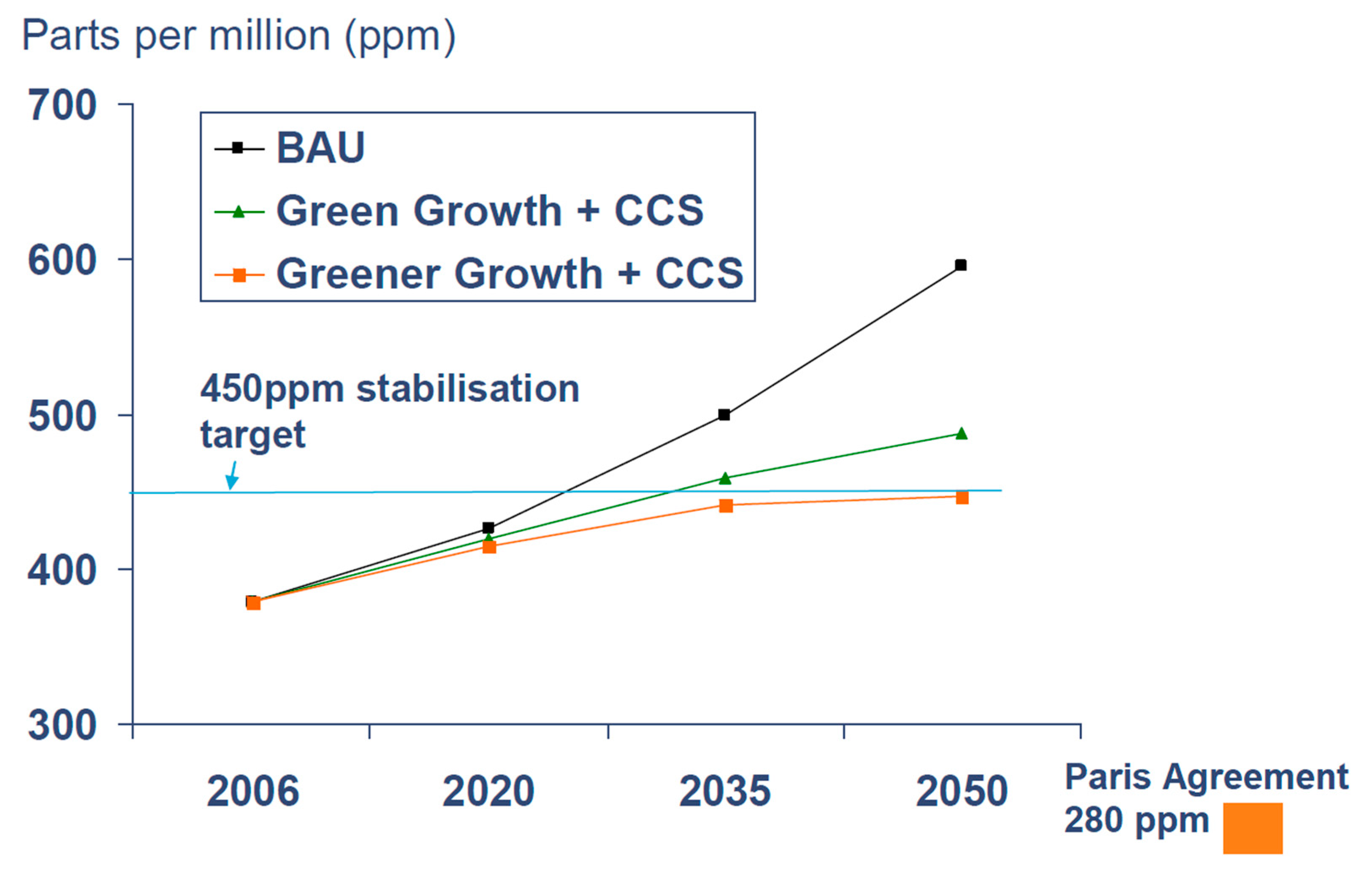
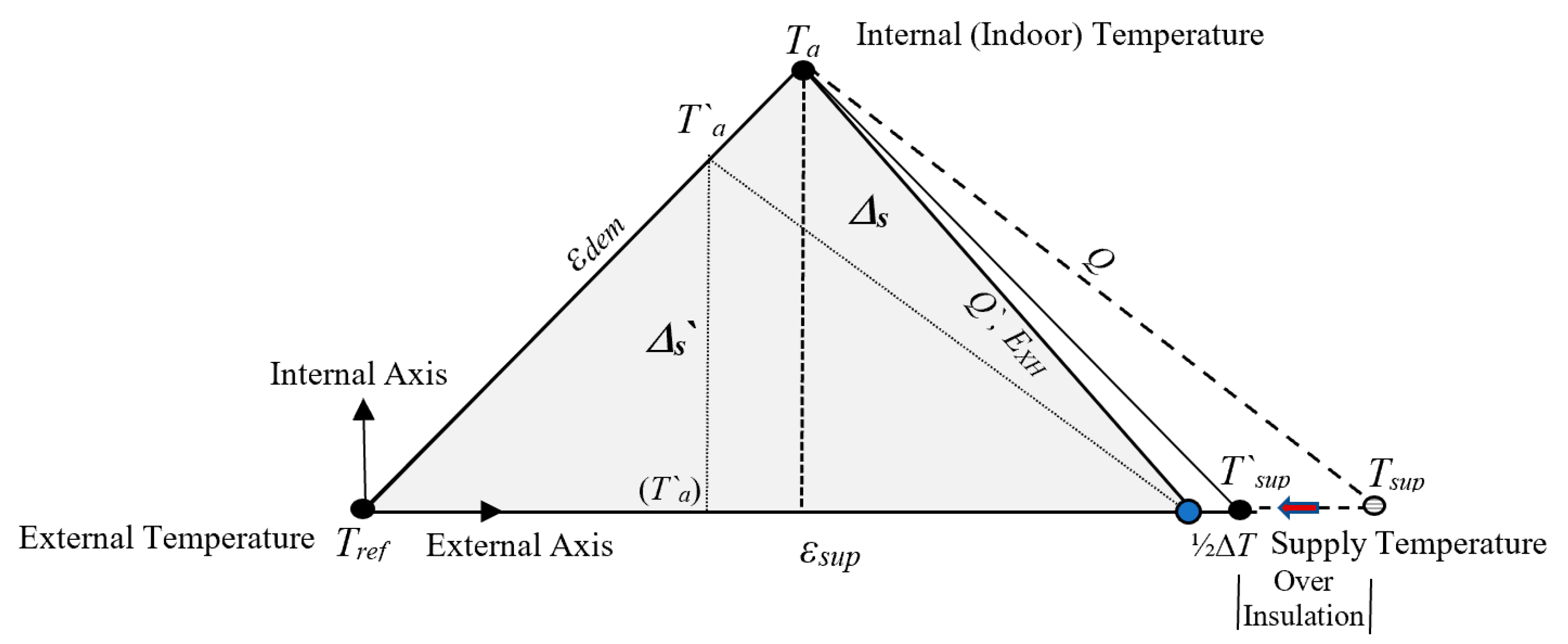

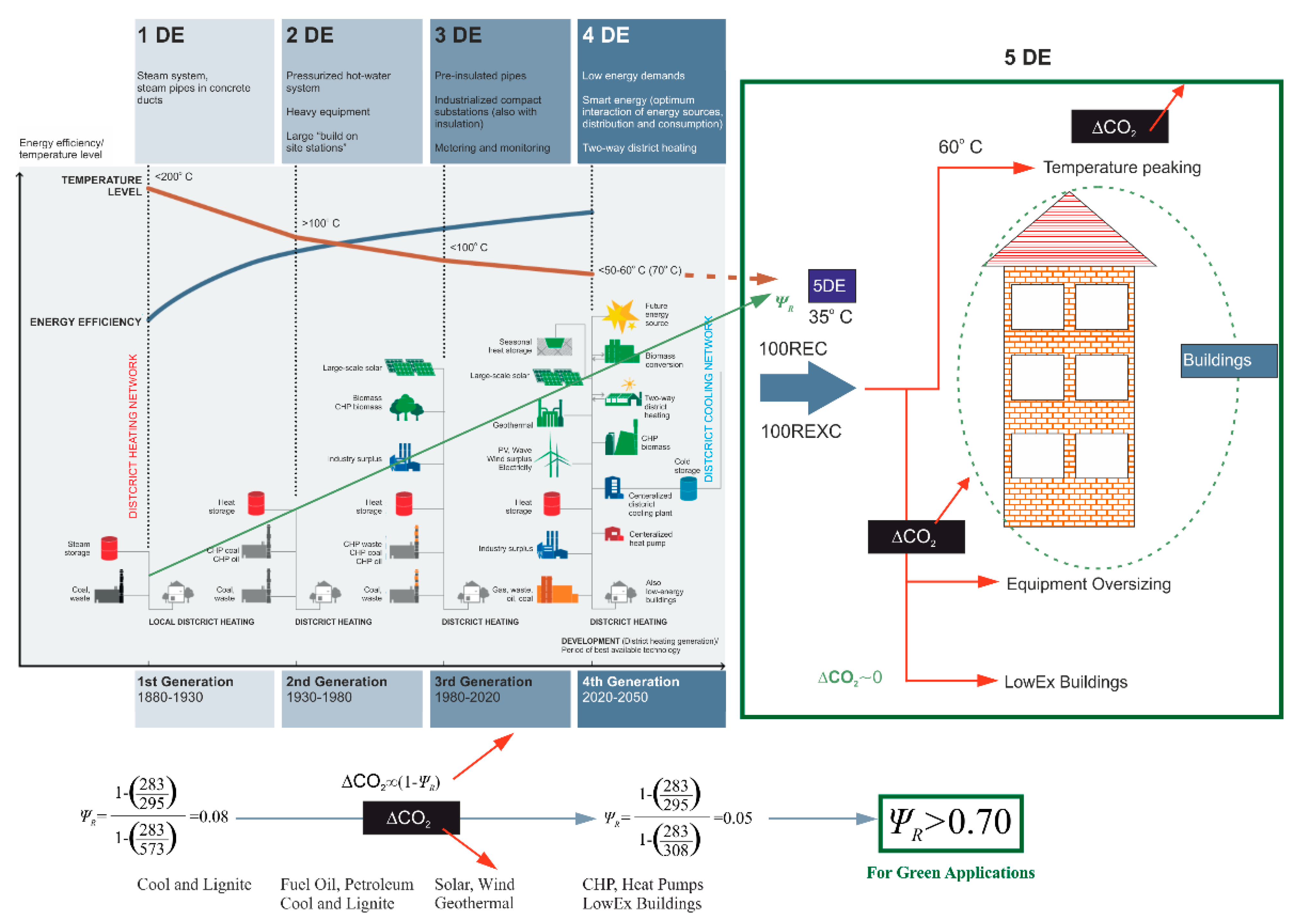
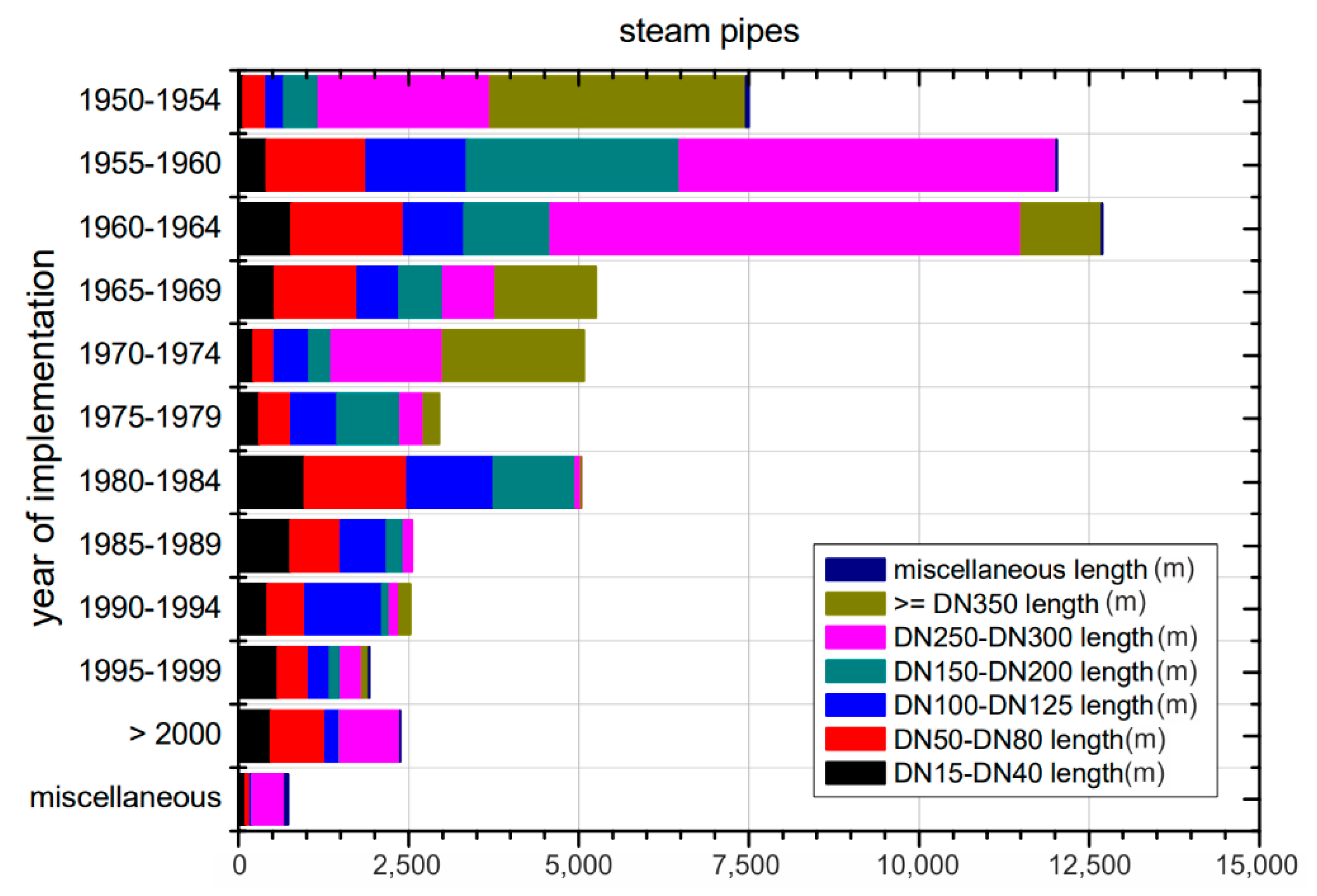

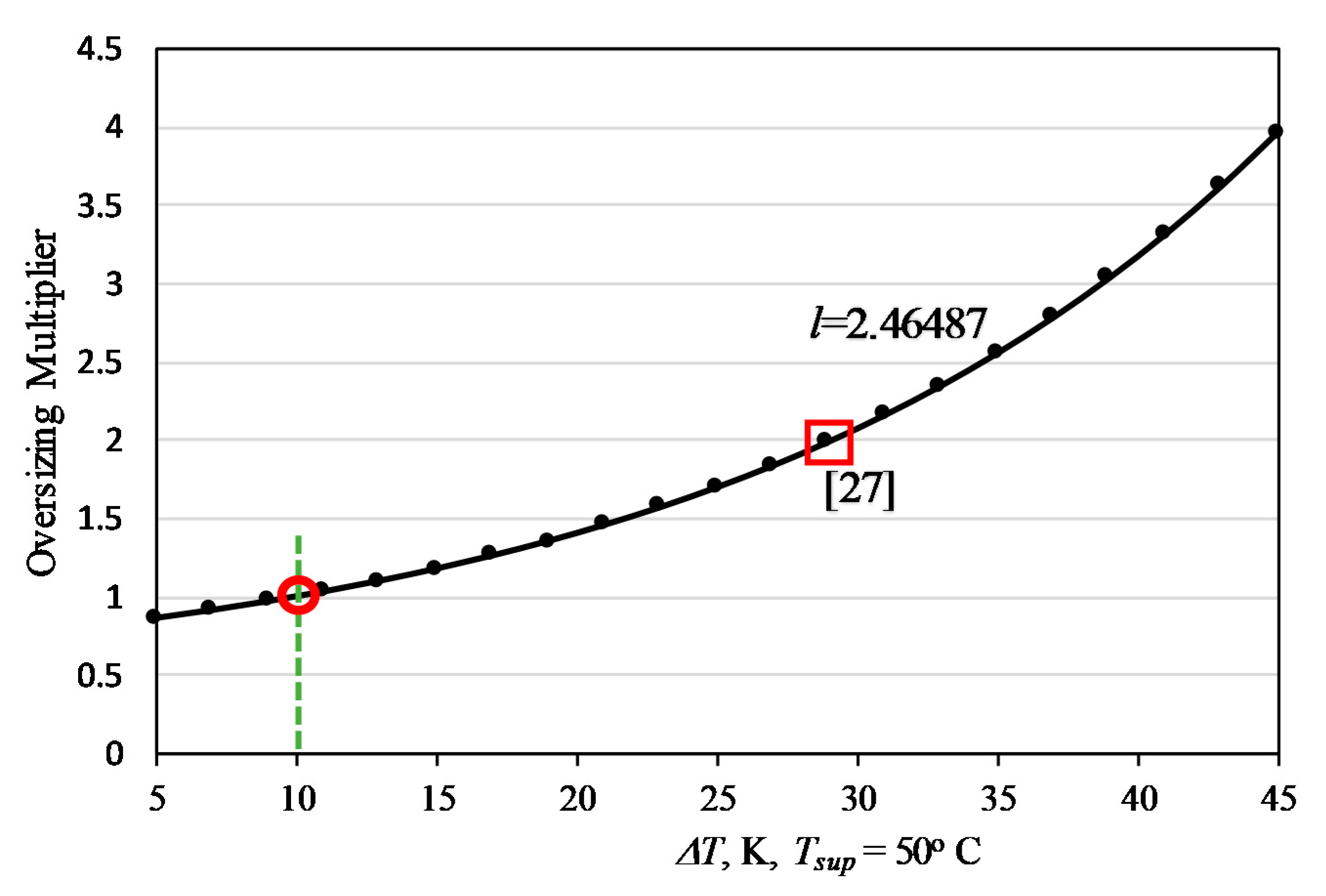

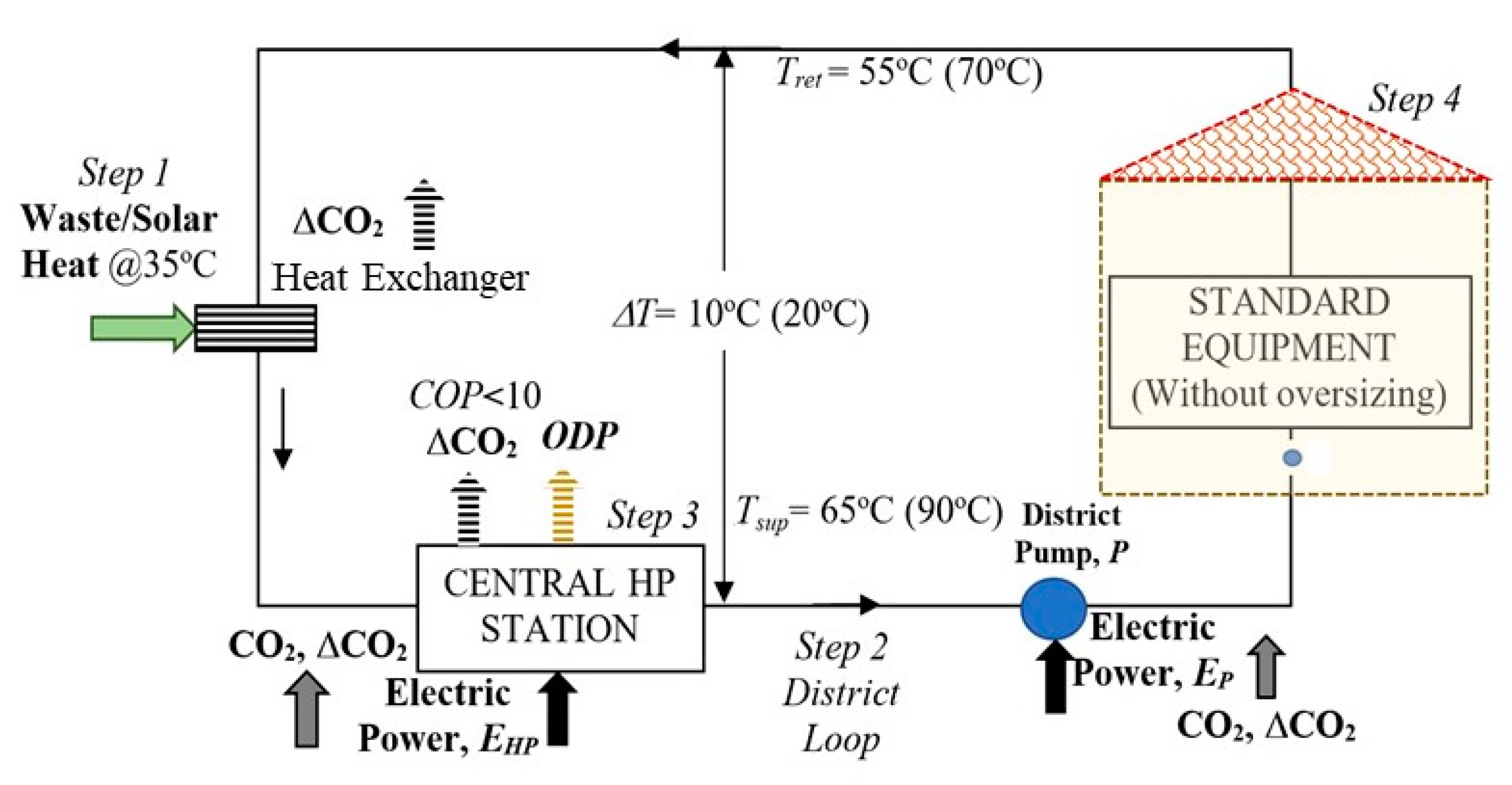
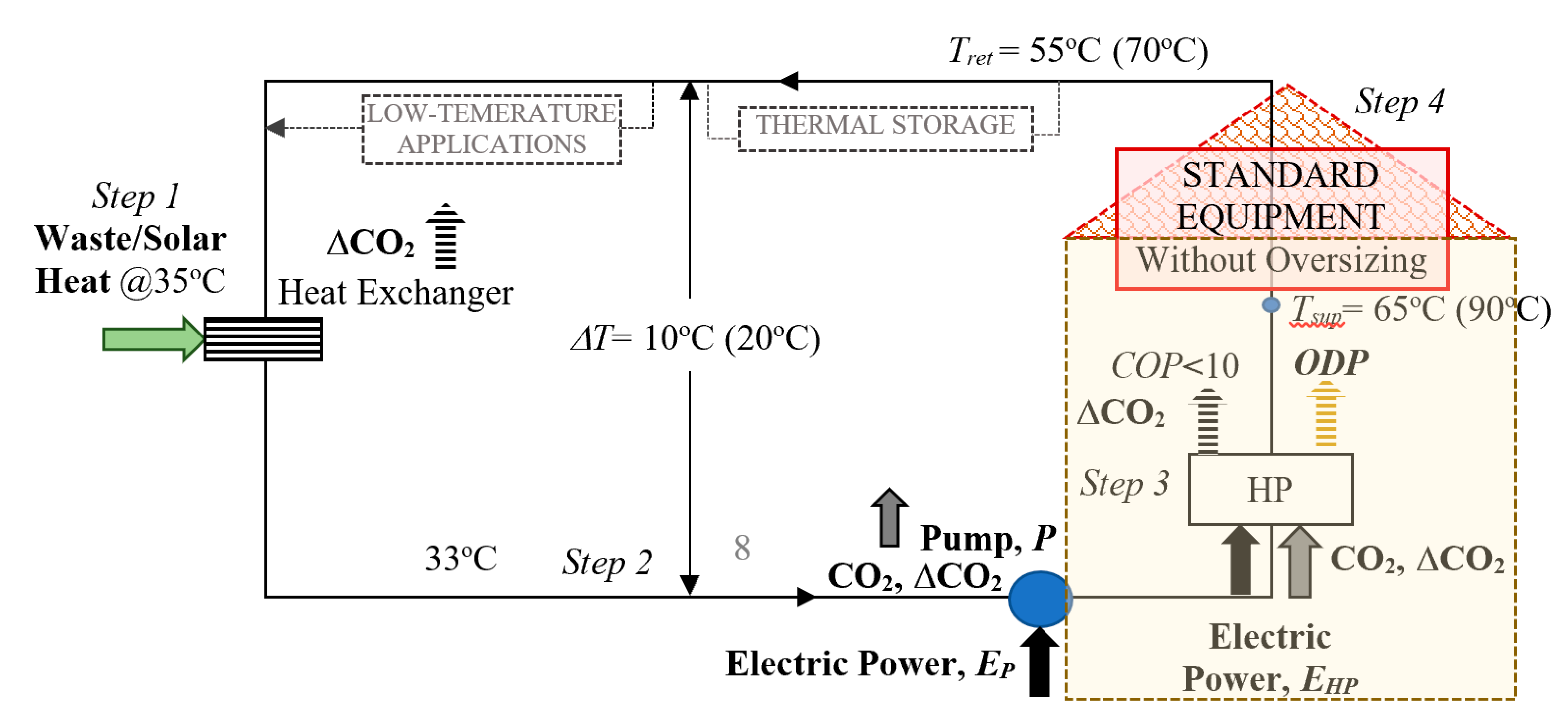


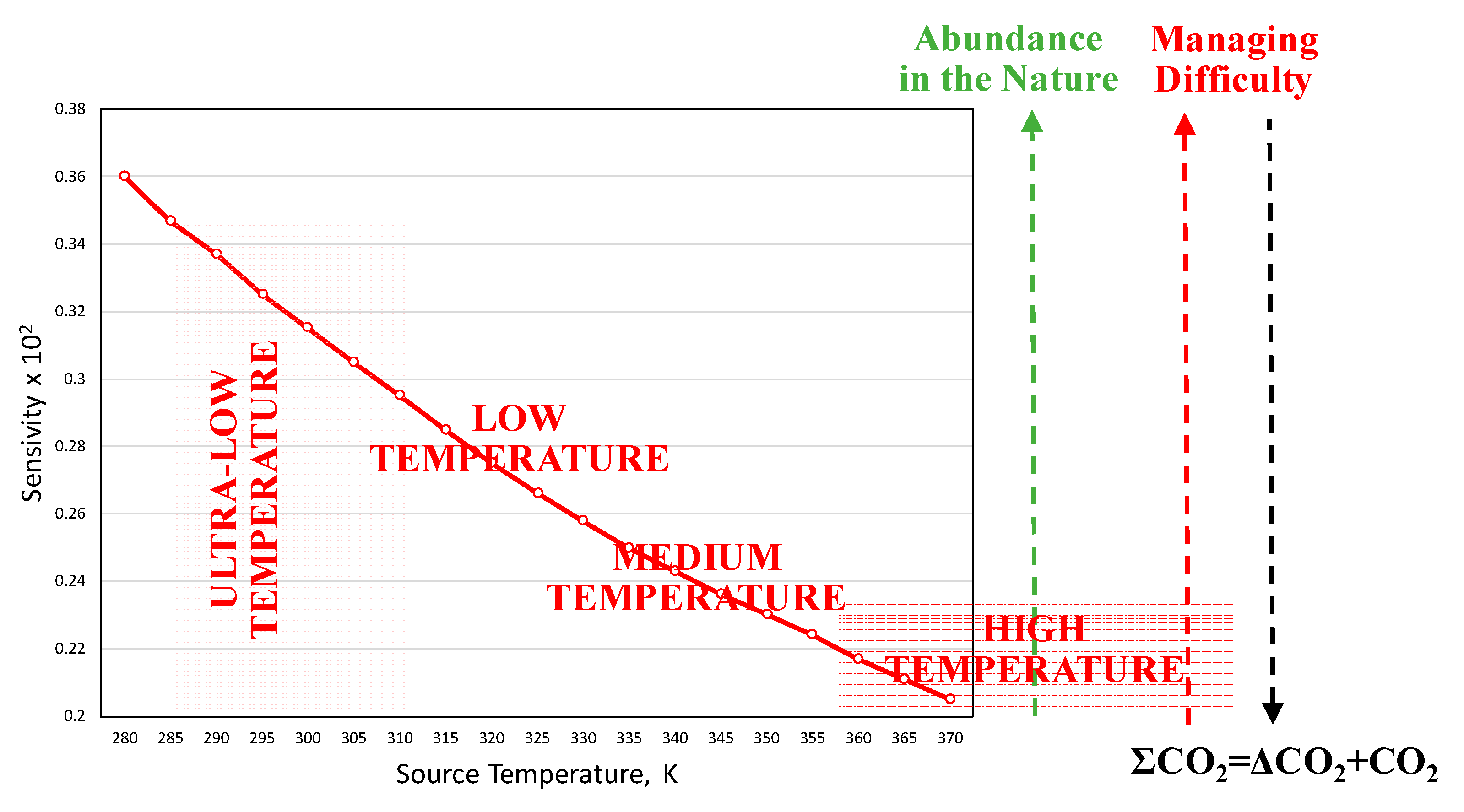

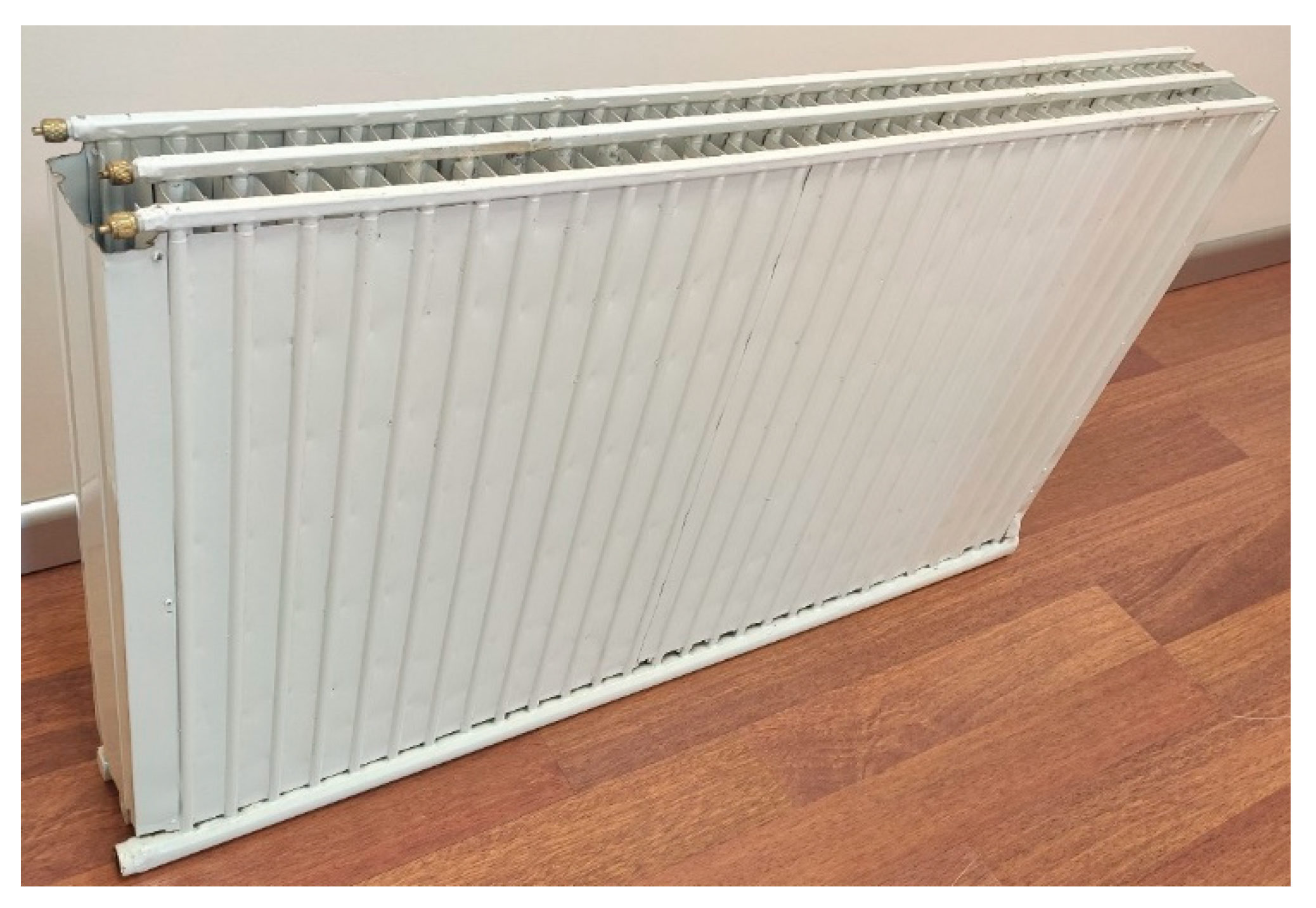
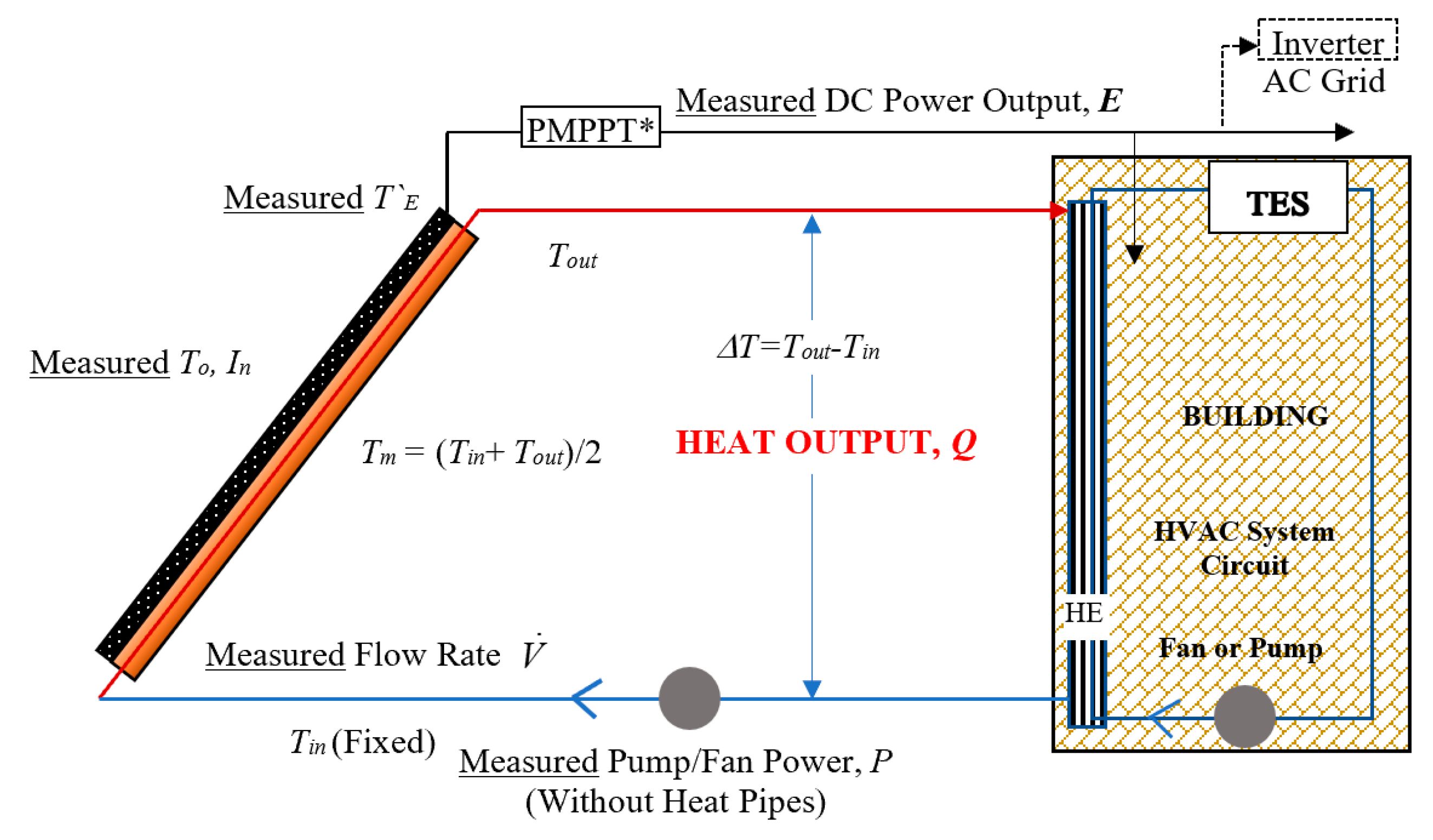


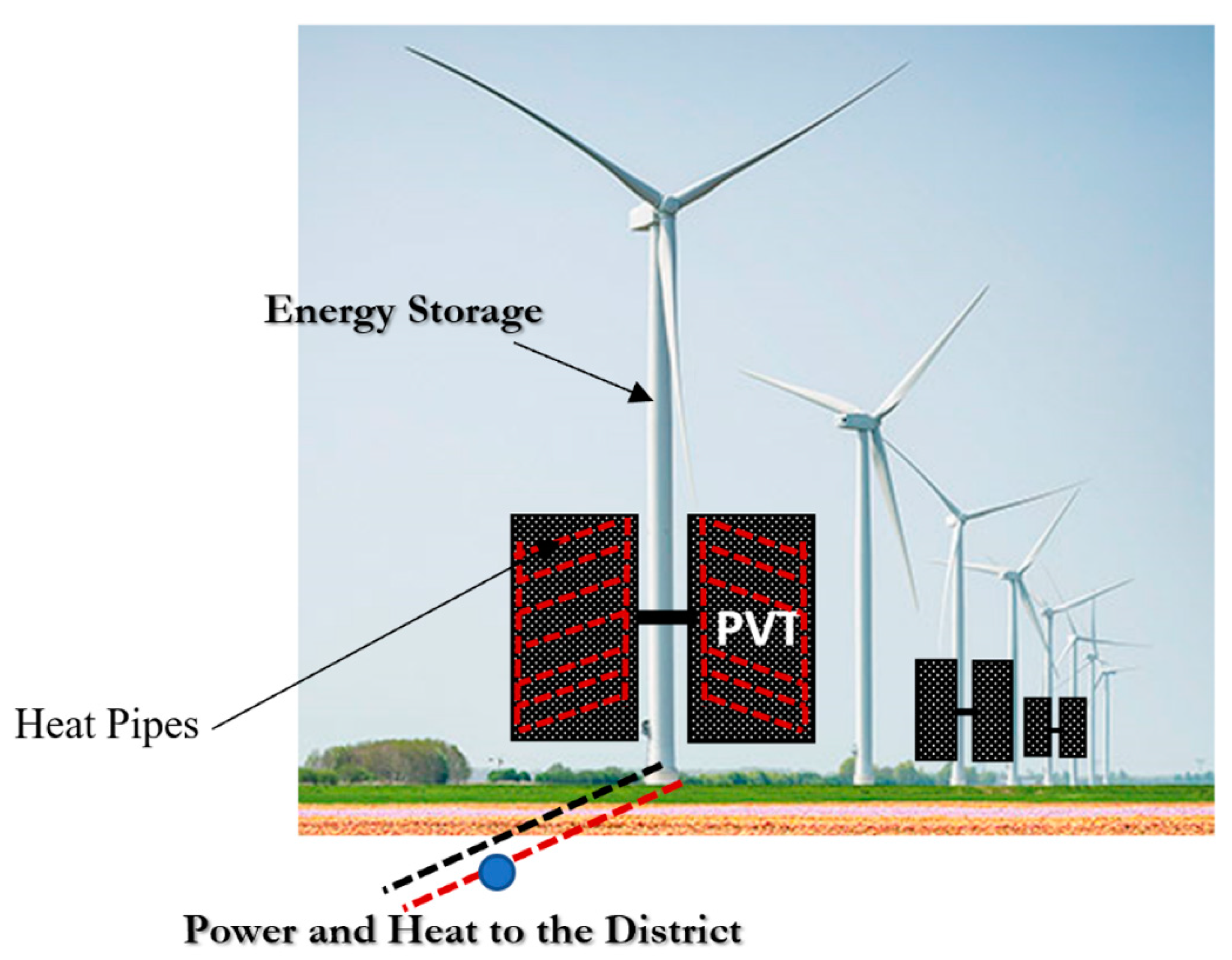

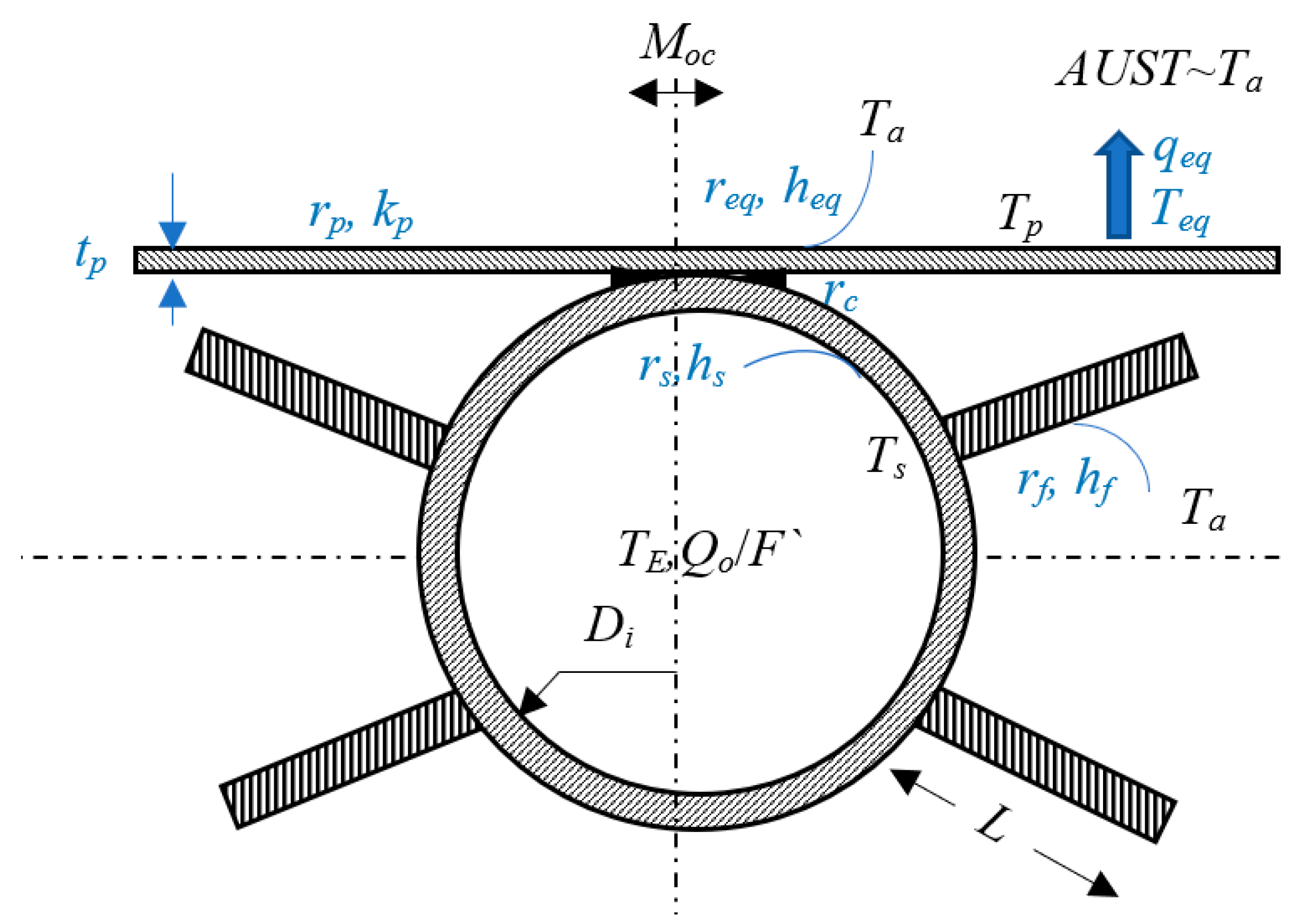

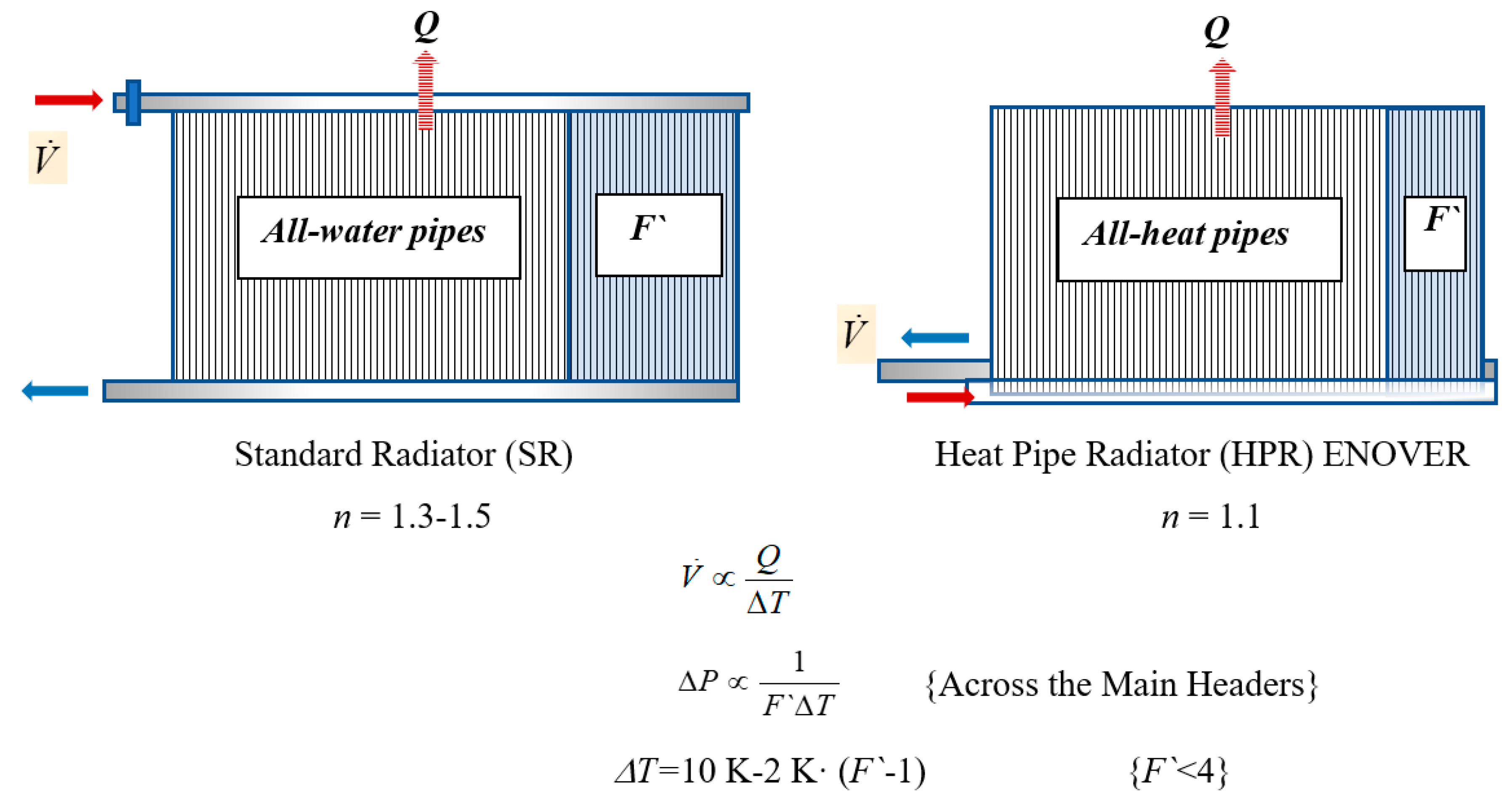
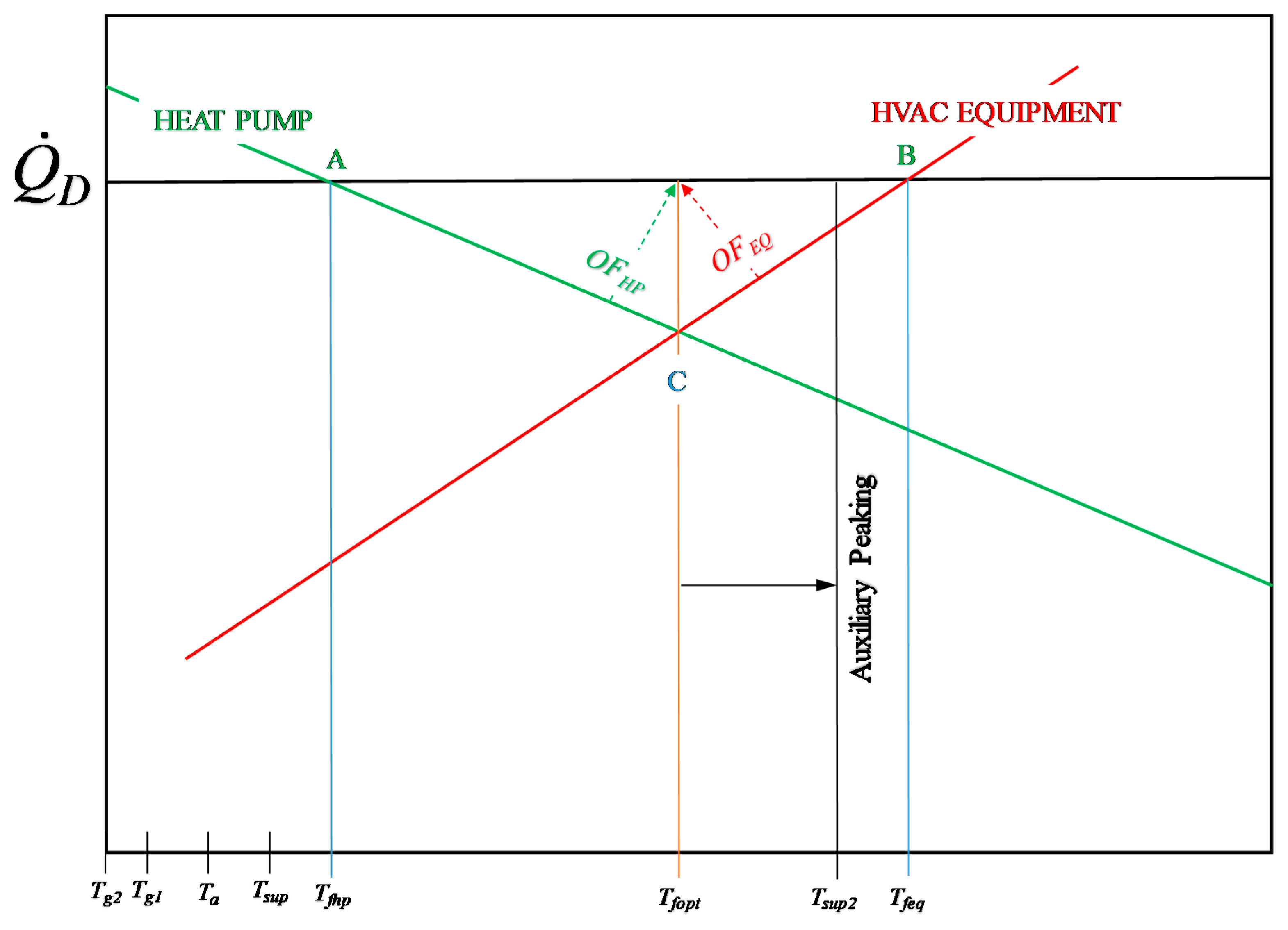
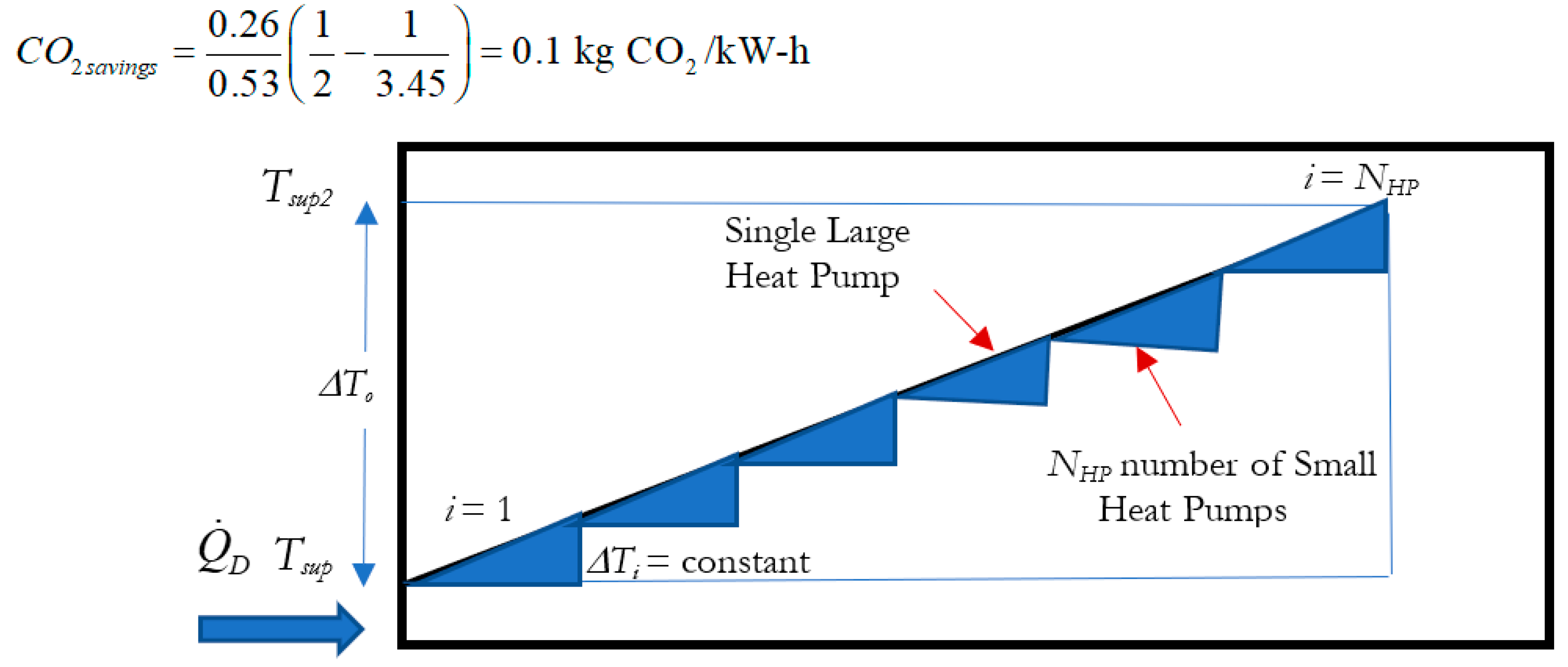
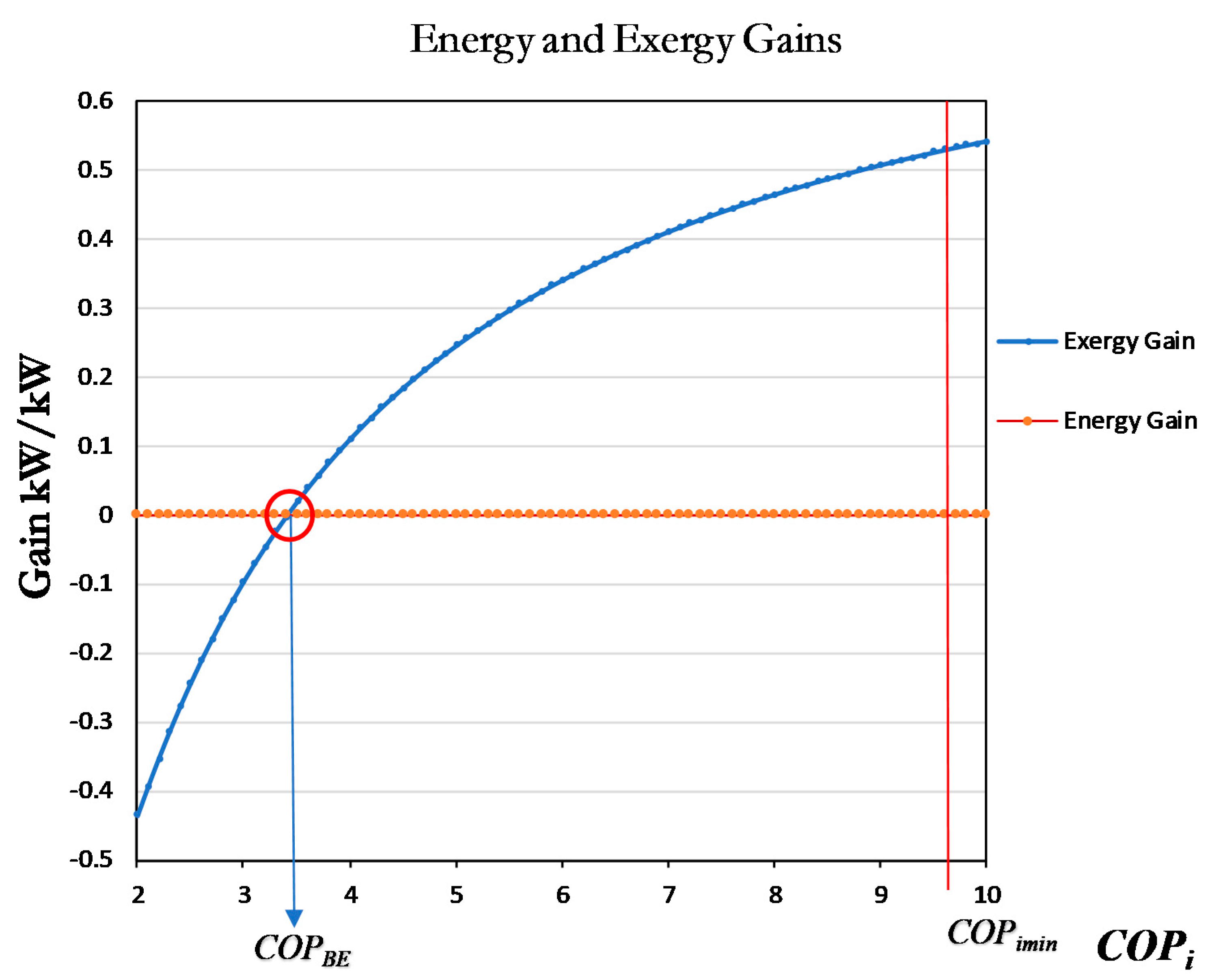
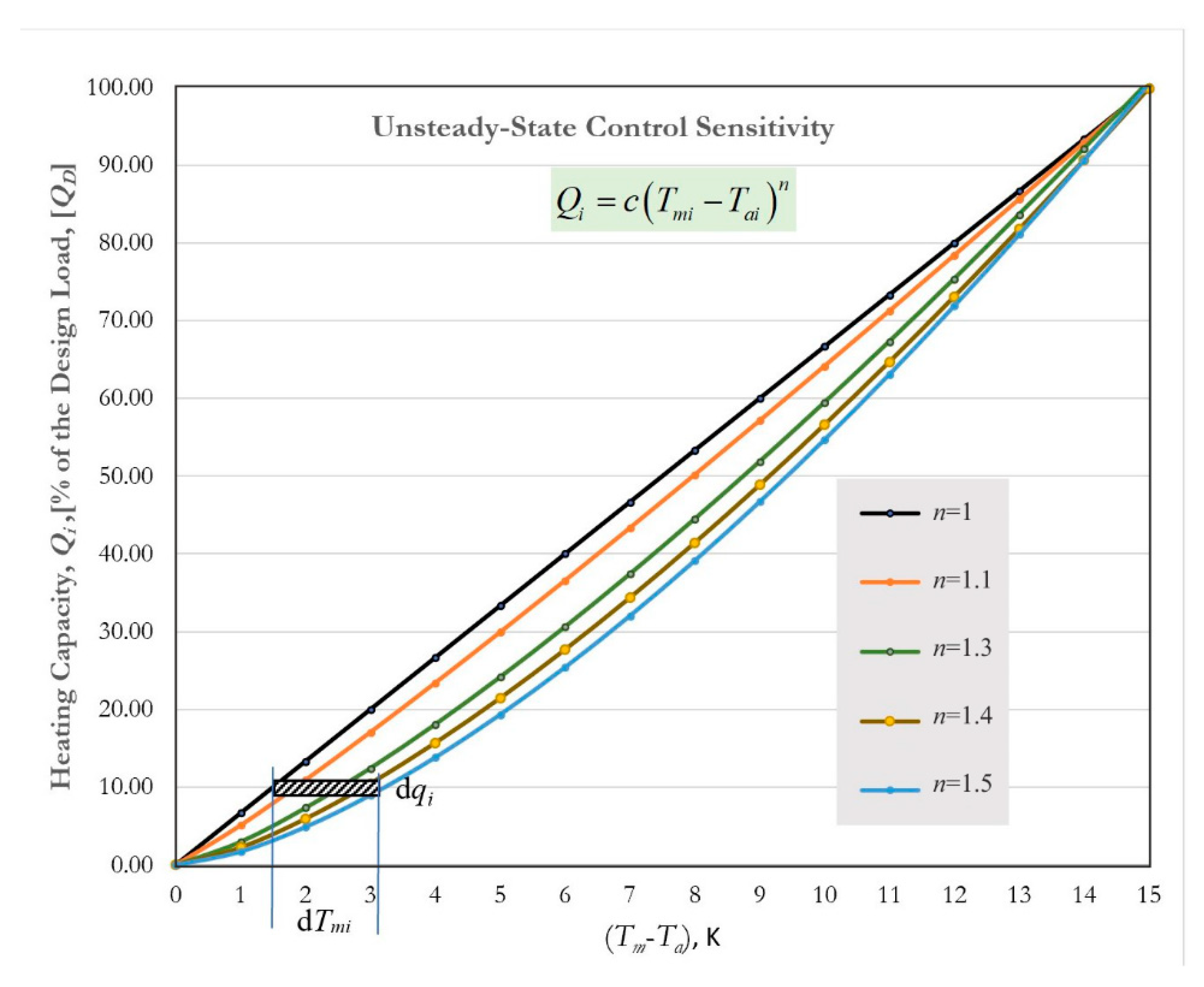
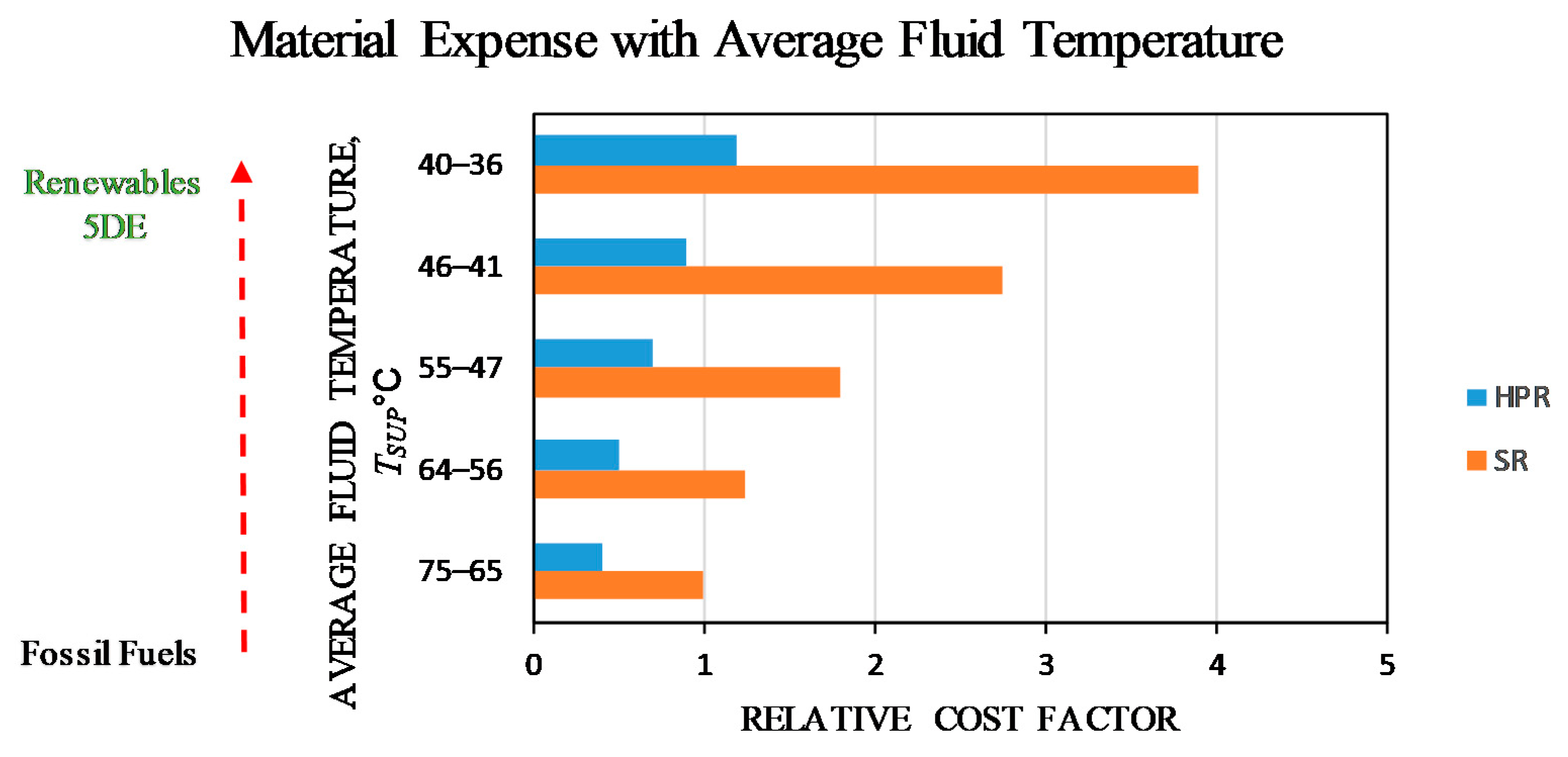
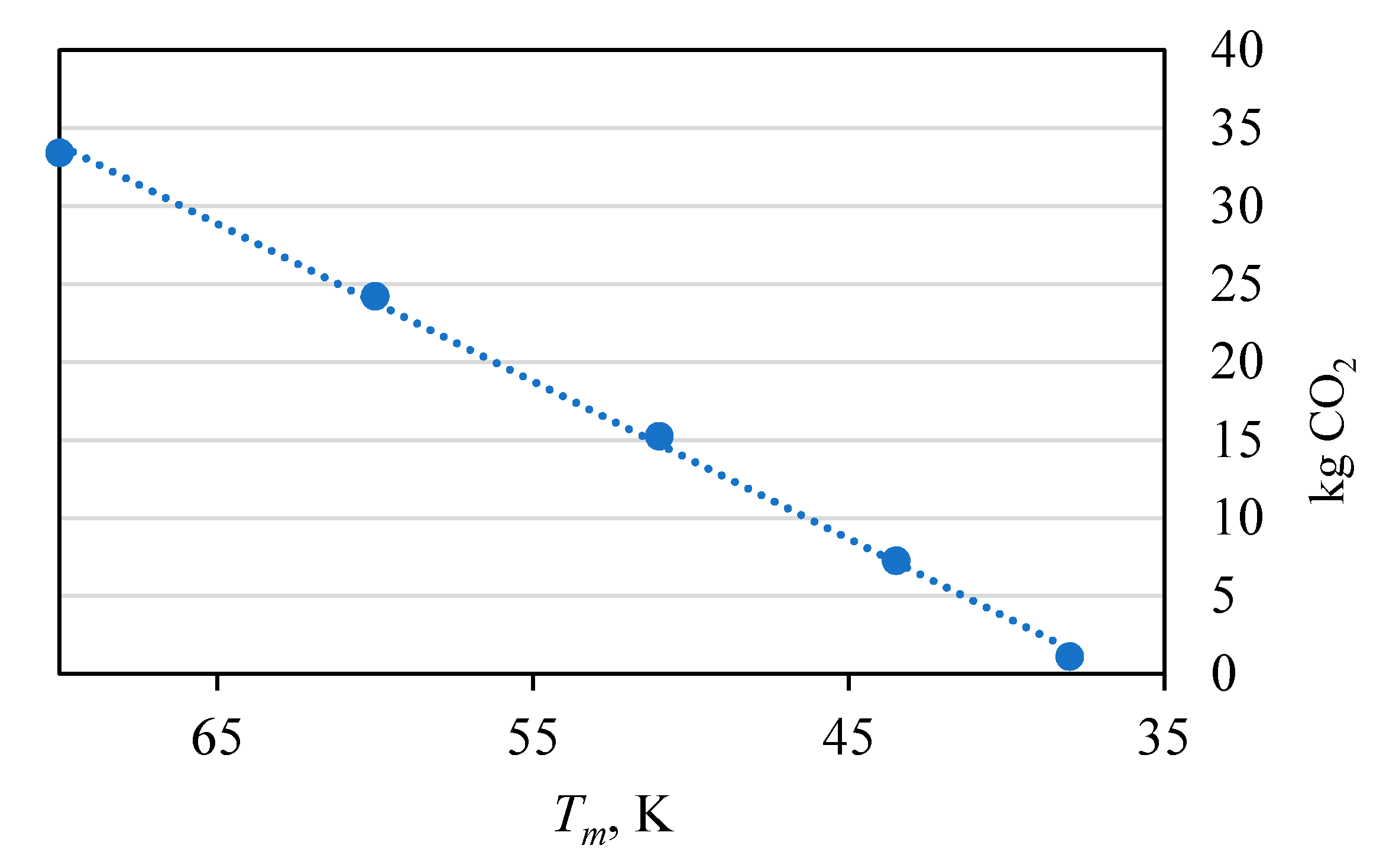
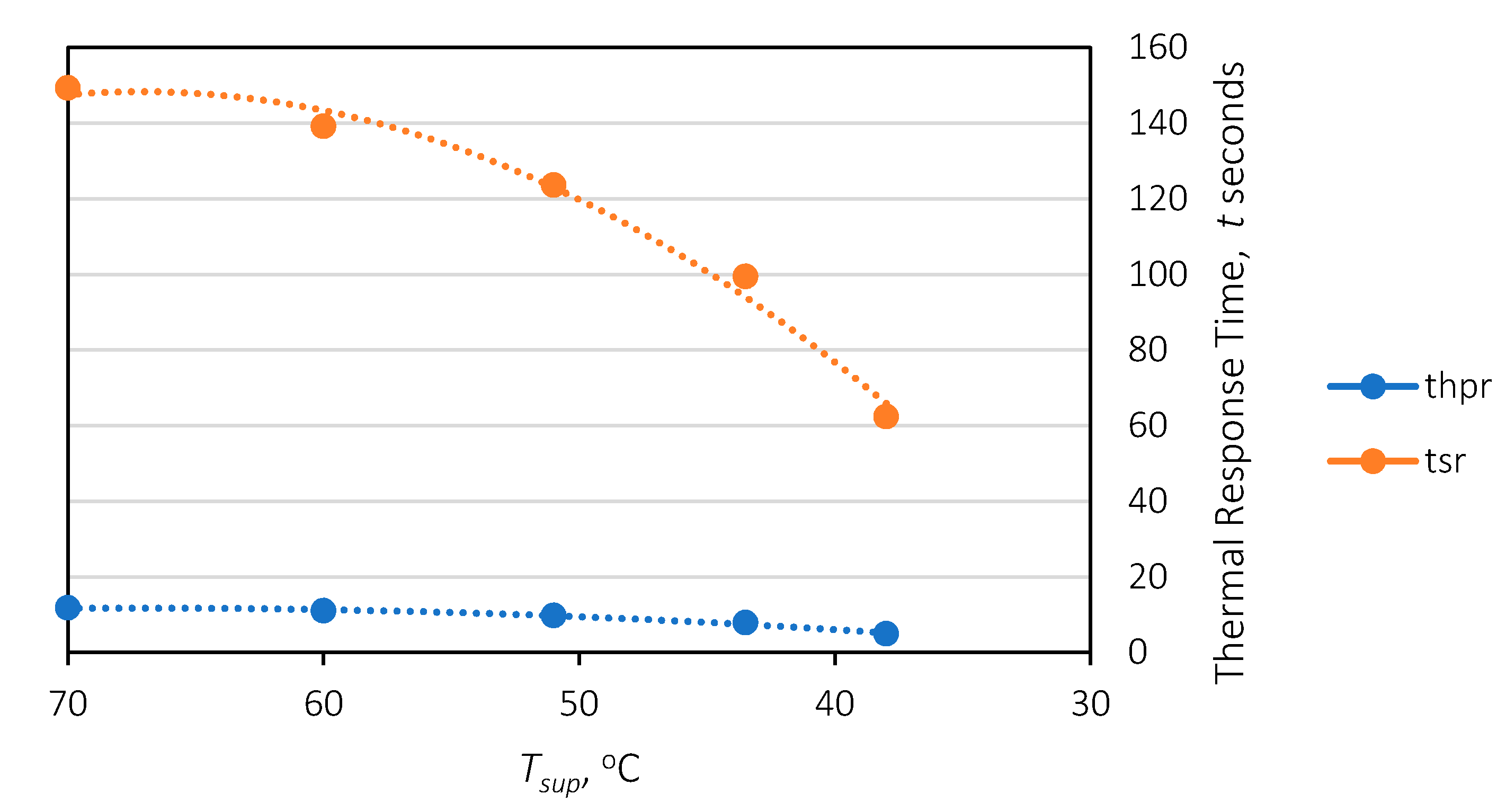
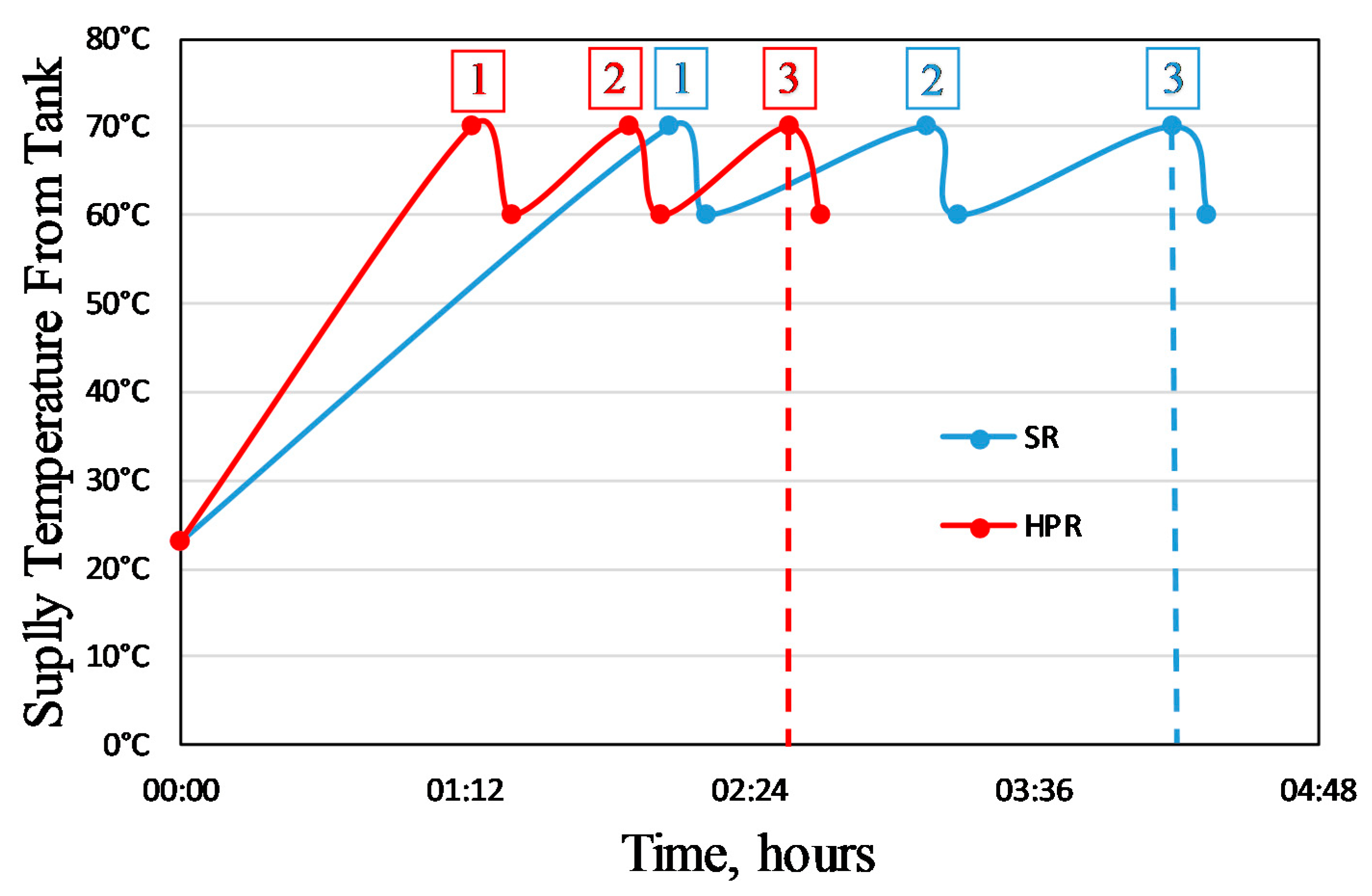
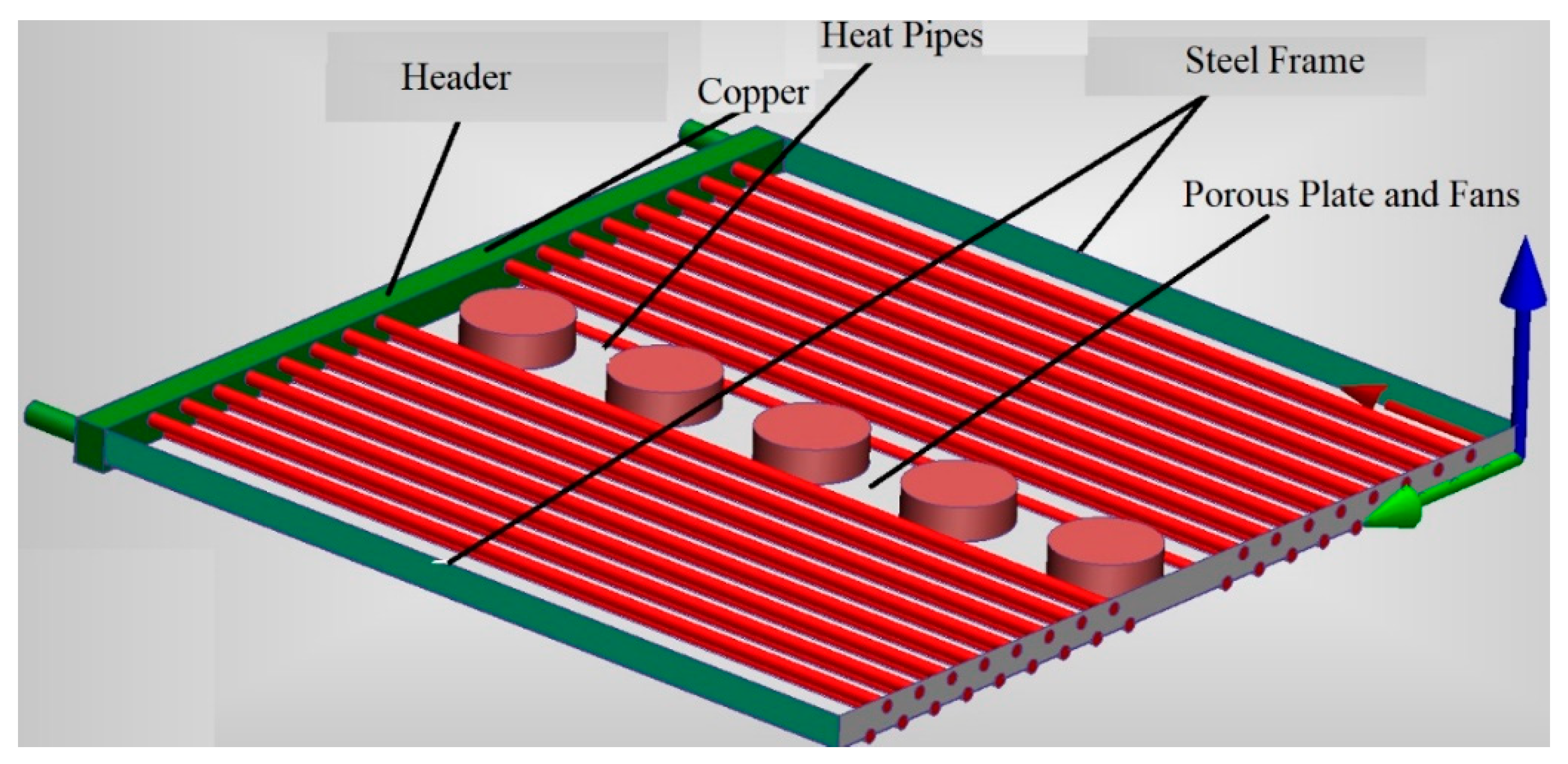
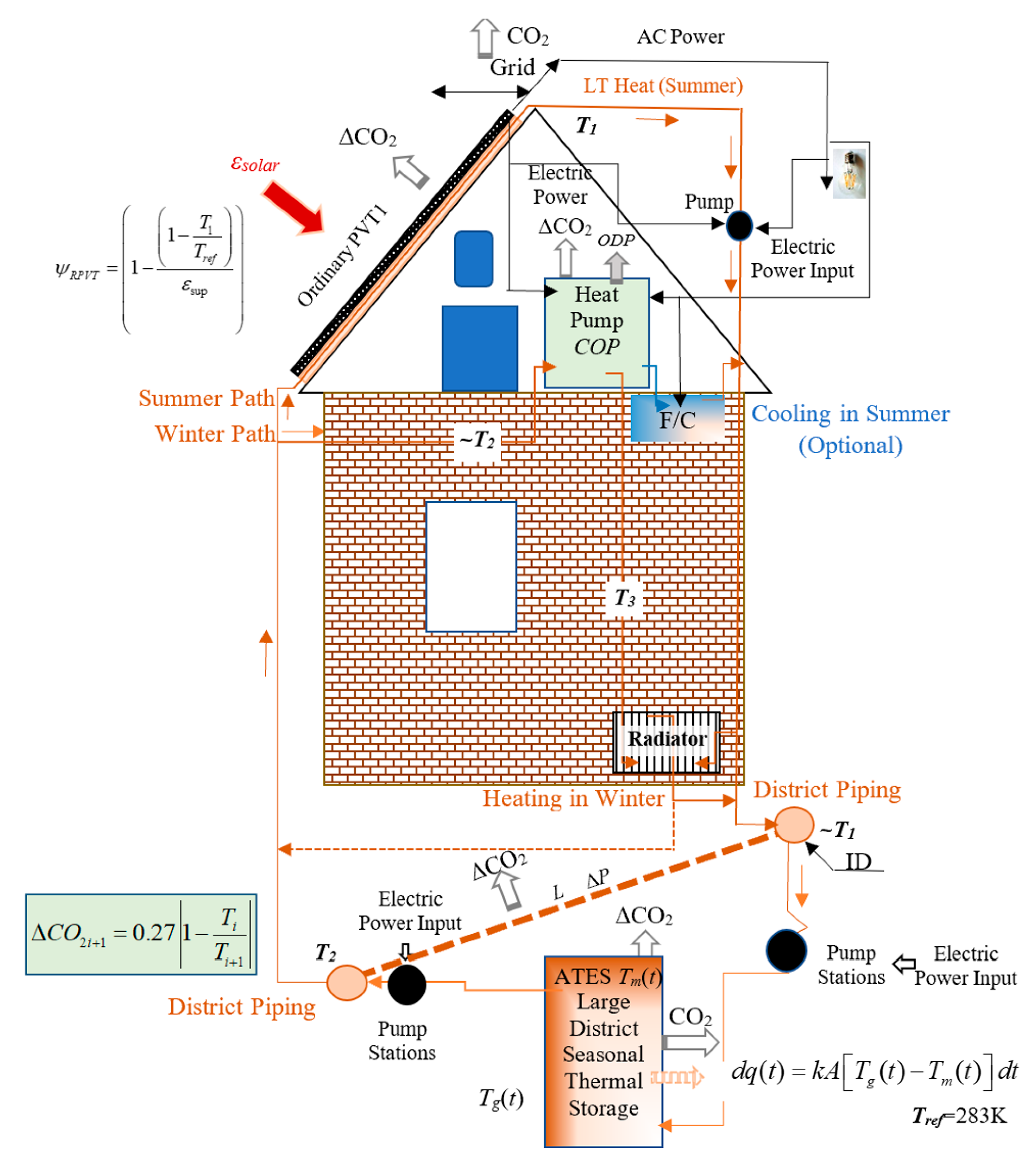
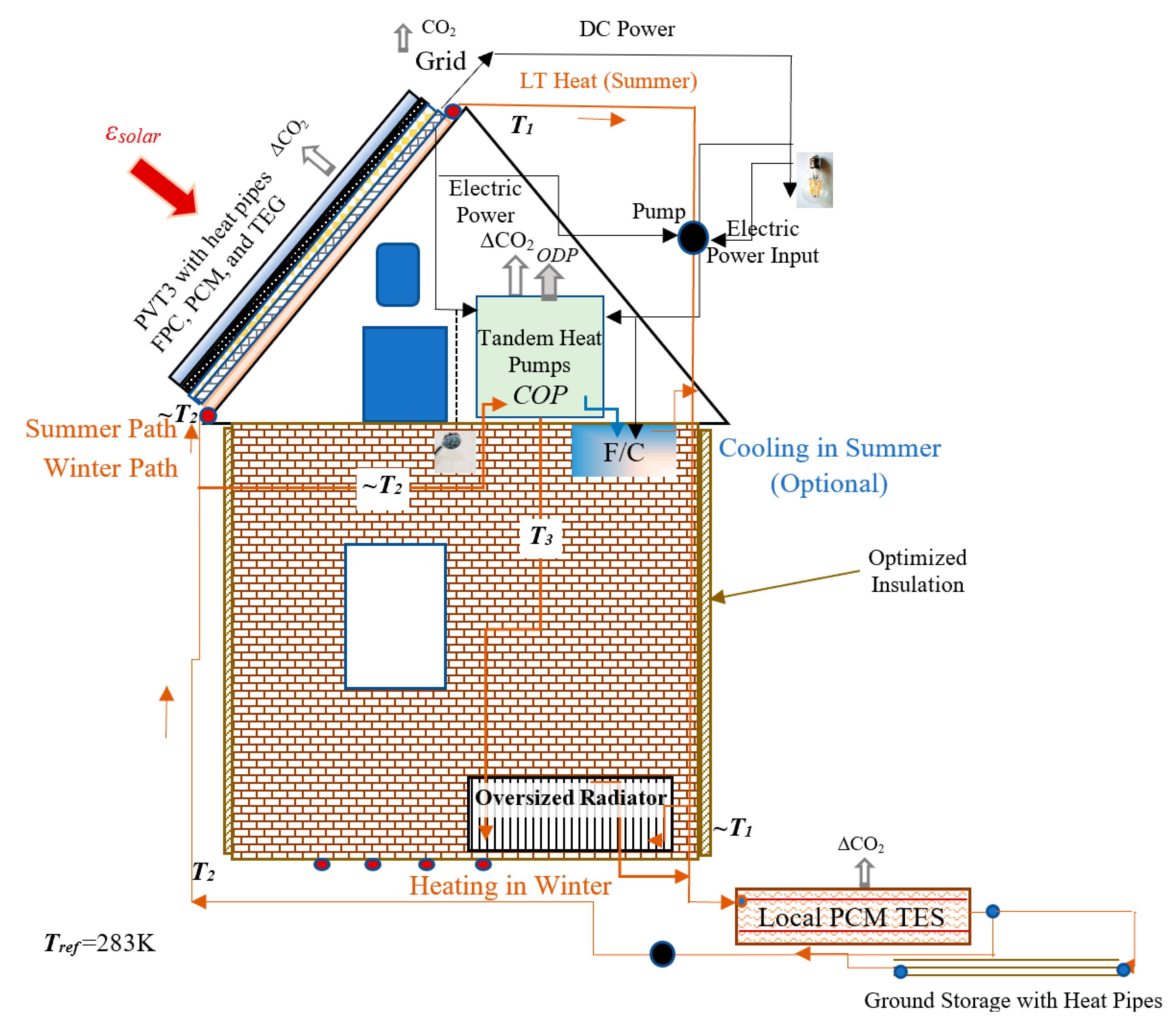
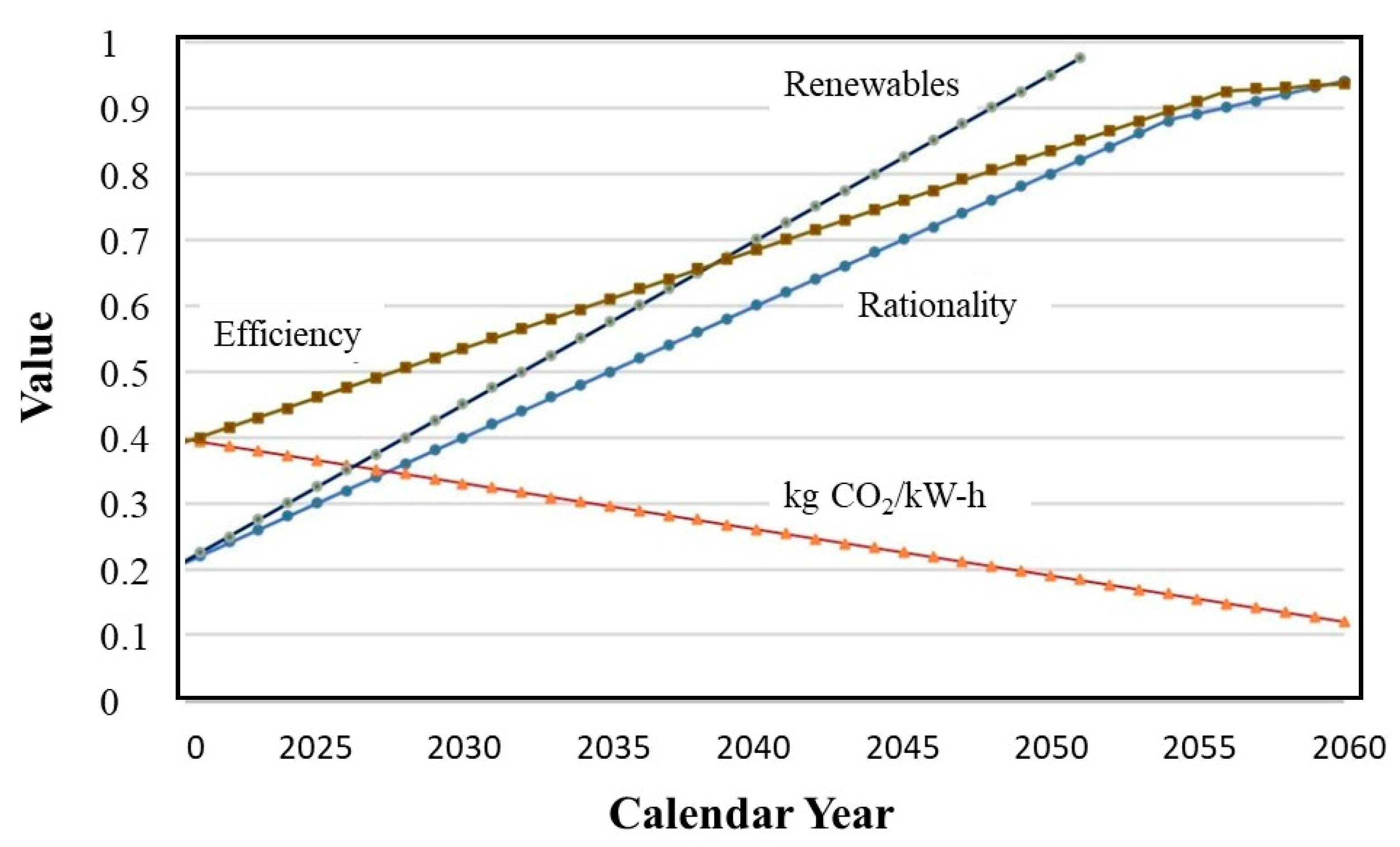
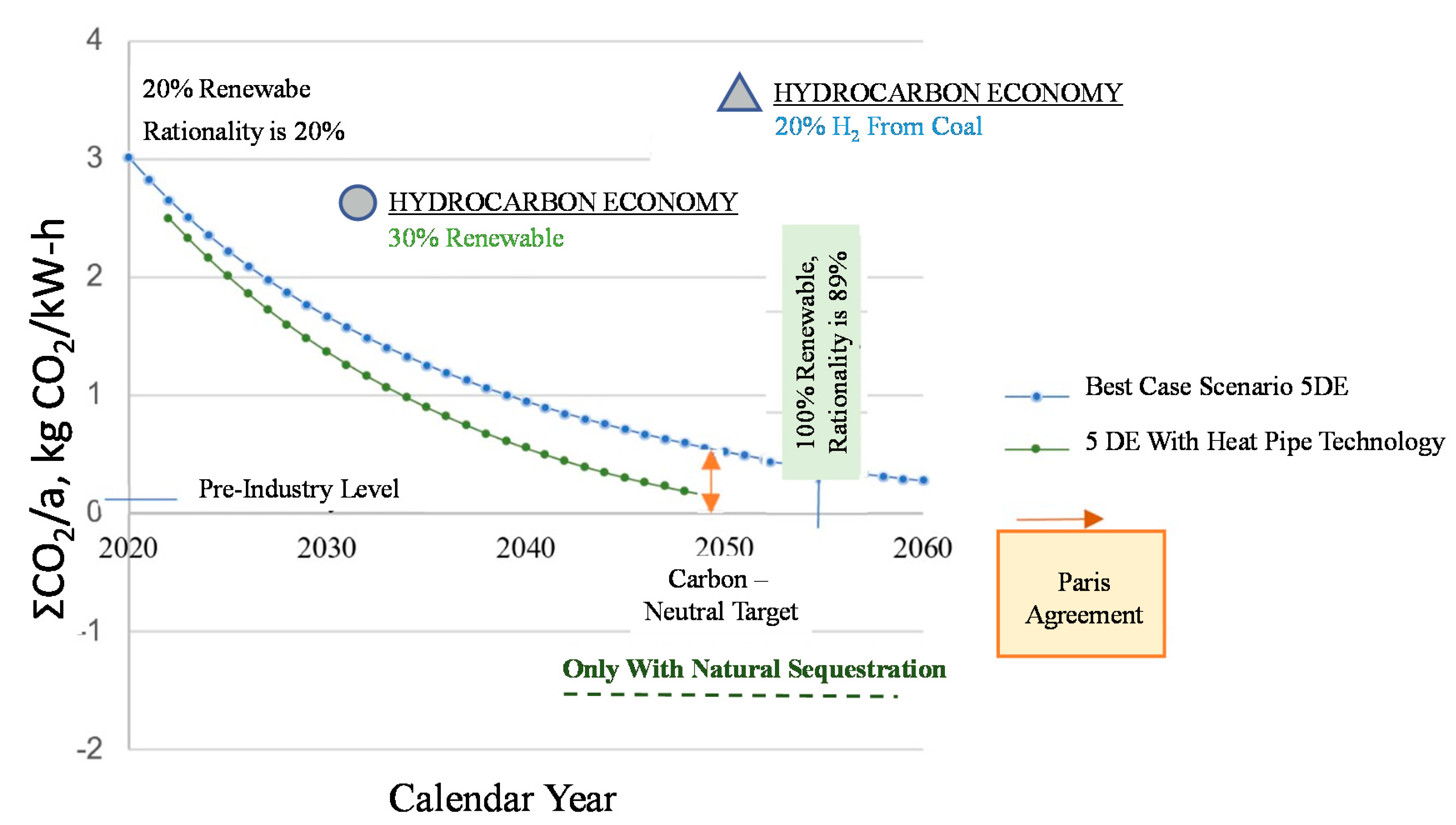
| EHP Position | |||
|---|---|---|---|
| Vertical | Horizontal | ||
| Thermal Conductance W/(m × K) | Mean Temperature, Tm, °C | Thermal Conductance W/(m × K) | |
| 13,840 | 90 | 13,340 | |
| 11,950 | 60 | 11,650 | |
| 9249 | 35 | 9050 | |
| Component | ODP | GWP | ODI | ΔCO2 | CO2 | ΣCO2 |
|---|---|---|---|---|---|---|
| kg CO2/kW-h | ||||||
| PVT1 pumps | - | - | - | 0.15 | 0.30 | 0.450 |
| Heat Pump | 0 | 550 | 0.124 | 0.045 | 0.33 * + 0.05 ** | 0.425 |
| District Pumps | - | - | 0.70 *** | 2.5 *** | 3.20 | |
| ATES | - | - | - | 0.35 *** | 0.15 *** | 0.450 |
| Domestic Pumps | - | - | - | 0.20 | 0.15 | 0.350 |
| Total | 1.445 | 3.48 | 4.925 | |||
| Component | ODP | GWP | ODI | ΔCO2 | CO2 | ΣCO2 |
|---|---|---|---|---|---|---|
| kg CO2/kW-h | ||||||
| PVT3 (No pump) | - | - | - | 0.05 | - | 0.05 |
| Cascaded Heat Pumps | 0 | 1 * | Negligible ** | 0.045 | Negligible | 0.425 |
| Local TES with PCM and TES | - | - | - | 0.01 | - | 0.01 |
| Domestic Pumps | - | - | - | 0.05 | - | 0.05 |
| Total | 0.155 | Negligible | 0.155 | |||
Publisher’s Note: MDPI stays neutral with regard to jurisdictional claims in published maps and institutional affiliations. |
© 2021 by the authors. Licensee MDPI, Basel, Switzerland. This article is an open access article distributed under the terms and conditions of the Creative Commons Attribution (CC BY) license (https://creativecommons.org/licenses/by/4.0/).
Share and Cite
Kılkış, B.; Çağlar, M.; Şengül, M. Energy Benefits of Heat Pipe Technology for Achieving 100% Renewable Heating and Cooling for Fifth-Generation, Low-Temperature District Heating Systems. Energies 2021, 14, 5398. https://doi.org/10.3390/en14175398
Kılkış B, Çağlar M, Şengül M. Energy Benefits of Heat Pipe Technology for Achieving 100% Renewable Heating and Cooling for Fifth-Generation, Low-Temperature District Heating Systems. Energies. 2021; 14(17):5398. https://doi.org/10.3390/en14175398
Chicago/Turabian StyleKılkış, Birol, Malik Çağlar, and Mert Şengül. 2021. "Energy Benefits of Heat Pipe Technology for Achieving 100% Renewable Heating and Cooling for Fifth-Generation, Low-Temperature District Heating Systems" Energies 14, no. 17: 5398. https://doi.org/10.3390/en14175398
APA StyleKılkış, B., Çağlar, M., & Şengül, M. (2021). Energy Benefits of Heat Pipe Technology for Achieving 100% Renewable Heating and Cooling for Fifth-Generation, Low-Temperature District Heating Systems. Energies, 14(17), 5398. https://doi.org/10.3390/en14175398






